EDITOR’S NOTE: Please be advised that this Chiang Mai travel guide hasn’t been updated in 2025. Prices and travel guidelines may no longer be accurate so it’s important that you verify any information before proceeding.
Chiang Mai is one of the most popular destinations in Thailand, perhaps second only to Bangkok in its appeal. It’s a cool mountain town known for its hill tribes, lush rainforests, elephant sanctuaries, and interesting cuisine.
If you enjoy going to Buddhist temples, then there are over 300 for you to visit in Chiang Mai. Night markets are aplenty as are digital nomads who’ve chosen to make this northern Thai city their home.
Many digital nomads travel to Chiang Mai hoping to stay for just a few weeks, then wind up staying a few months instead.
It’s such a liveable city that offers a near perfect blend of pace, affordability, comfort, culture, nature, and nightlife.
Spend a few days in Chiang Mai, and you’ll see exactly what I mean.
VISIT CHIANG MAI QUICK LINKS
This travel guide to Chiang Mai is long. For your convenience, I’ve compiled links to hotels, tours, and other services here.
HOTELS
Top-rated hotels in the Old Town, the most convenient area to stay for first-time visitors to Chiang Mai.
- Luxury: The Inside House
- Midrange: 18 In Town Homestay
- Budget: The Newnormal House
TOURS
- Sightseeing Tour: Chiang Mai Old City & Temple Tour
- Food Tour: Evening Local Street Food Market Tour
- Day Trip: Doi Inthanon National Park Small Group Full Day Tour
TAGTHAi
Save on your trip to Chiang Mai with the TAGTHAi Pass!
OTHER SERVICES
- Visa Services
- Travel Insurance with COVID cover (WFFF readers get 5% off)
- Airport Transfer
- Car Rental
- Wifi and Sim Cards / eSIM
Save This on Pinterest!
No time to read this Chiang Mai travel guide now? Click on the save button and pin it for later!
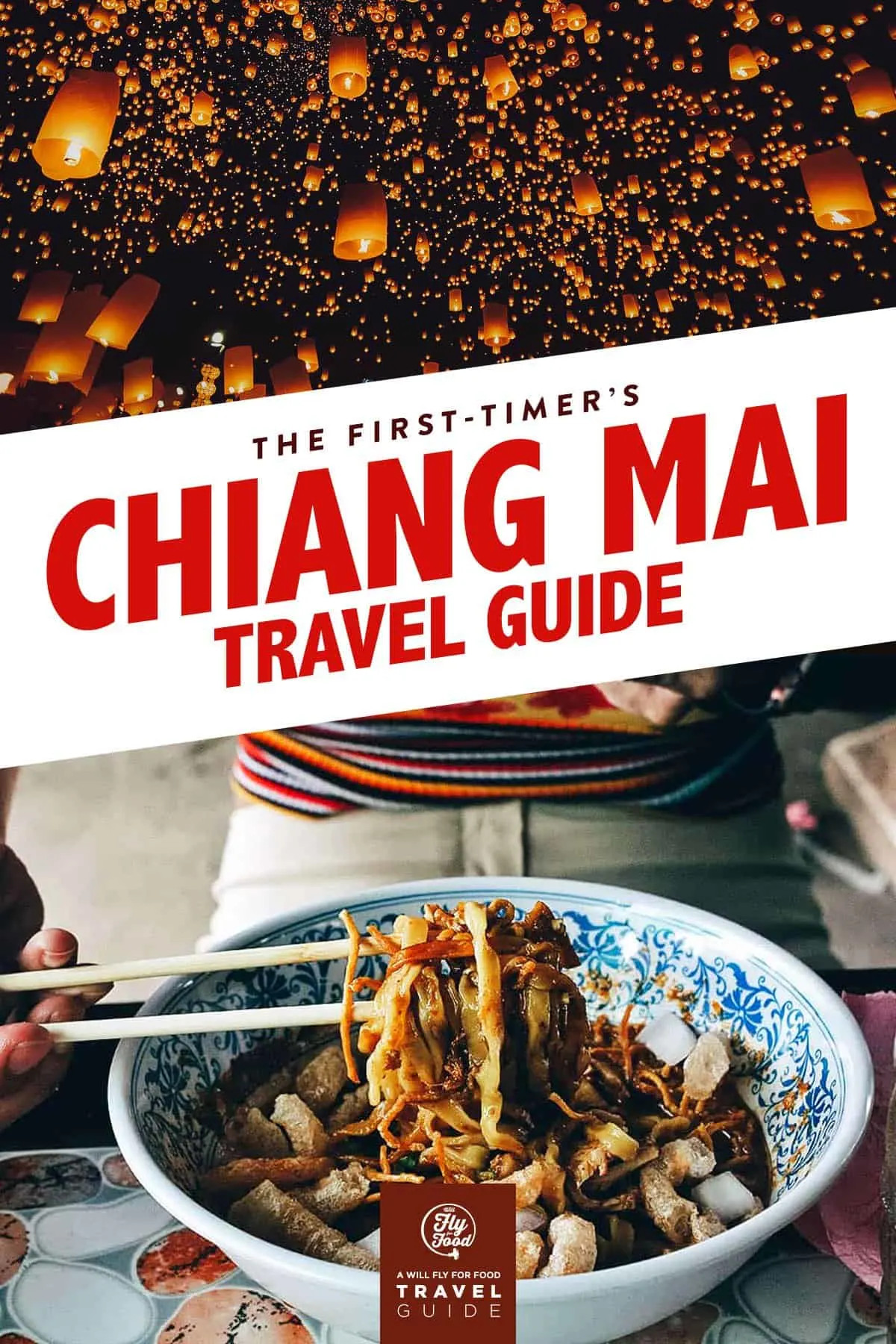
GUIDE TABLE OF CONTENTS
CHIANG MAI TRAVEL RESTRICTIONS
Because of the current global situation, Chiang Mai travel guidelines have been changing regularly. Our friends at Booking.com created a website that lists detailed information on travel restrictions around the globe.
Before planning a trip to Chiang Mai, be sure to check Booking.com for information on travel restrictions to Thailand. If you do decide to visit Chiang Mai, then you may want to seriously consider getting travel insurance with COVID coverage.
THAILAND VISA
You may need a visa and other documents to visit Thailand depending on your passport. Check out iVisa.com to learn about the requirements and to apply for a visa (if necessary).
CHIANG MAI AT A GLANCE
Chiang Mai is the largest city in Northern Thailand. It was once the capital of the Lanna Kingdom and is considered one of the most culturally significant cities in the region.
At its historical center is the Old City, a roughly 1.6 km walled and moated square that’s home to over 30 Buddhist temples, some of which are as old as the city itself.
As well-preserved as it is, don’t let the city’s historical and cultural appeal fool you. Chiang Mai has modernized in many ways and expanded far beyond the walls of the Old City. In fact, it’s become a haven for backpackers and digital nomads in recent years.
Go through the travel blogosphere and you’ll find that many long-term travelers have spent a good amount of time in Chiang Mai. I don’t know when it all started, but I think the city’s laid back atmosphere and relatively low cost of living have a lot to do with it.
If you’re on a gap year and traveling to Chiang Mai for the first time, then don’t be surprised if you wind up staying longer than anticipated. Many people do. Chiang Mai is that type of destination.
BEST TIME TO VISIT CHIANG MAI
Weather-wise, November to February is the ideal time to visit Northern Thailand. It’s the coolest and driest time of the year.
We visited Chiang Mai in early November to partake in the Yee Peng and Loy Krathong Festivals. It’s a popular event that attracts thousands of tourists every year, making it one of the most vibrant times to be in the region.
NOV-FEB: As advised, November to February is the most comfortable time to be in Chiang Mai. Daytime temperatures hover around 25°C (77°F) with few rainy days. The Yee Peng Festival usually happens in November every year so you may want to plan your trip around that. If you enjoy flowers, then you may want to go in February to attend the Chiang Mai Flower Festival.
MAR-MAY: March to May is the hottest time to be in Northern Thailand with temperatures often reaching 40°C (104°F). It isn’t the most comfortable time to visit, but Songkran or the Thai New Year is celebrated every April and turns the city into a giant water fight.
JUN-OCT: This is the monsoon season in Northern Thailand and probably not the best time to visit the region.
Climate: Annual Monthly Weather in Chiang Mai
To help you better understand the weather in Chiang Mai, I’ve put together average temperature and annual rainfall graphs below. Suggested months to visit are indicated in orange.
Average Temperature
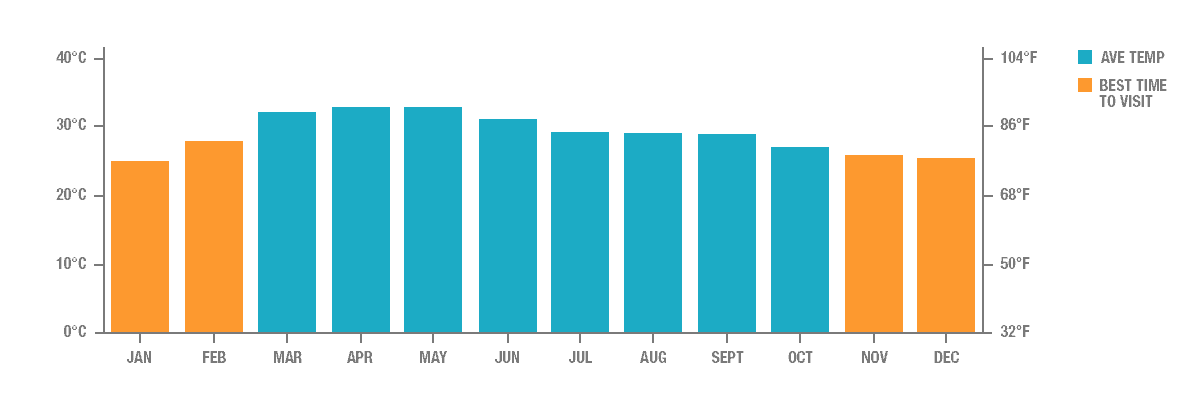
Annual Rainfall
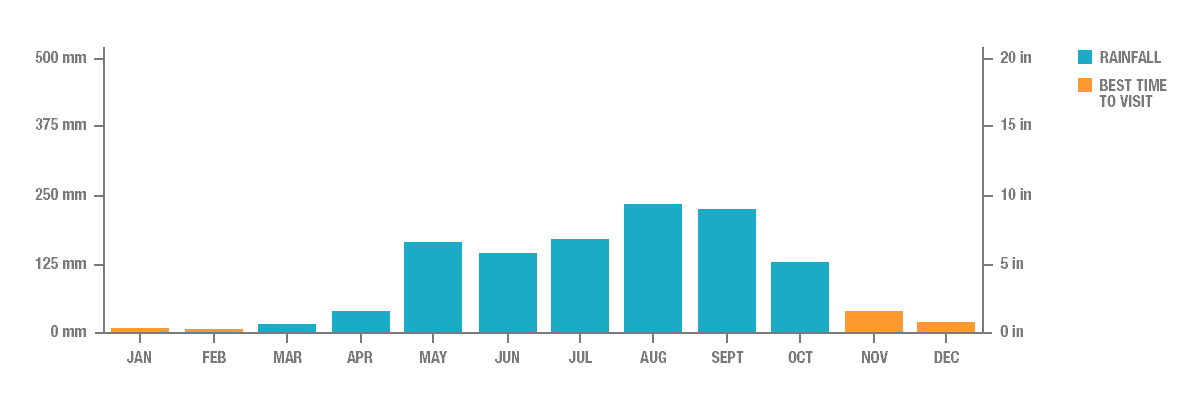
TRAVELING TO CHIANG MAI
From Bangkok, we flew and spent a couple of nights in Chiang Rai first before taking the 3-hour Green Bus to Chiang Mai. Between the two Northern Thai cities, Chiang Mai is more frequently visited so I imagine most tourists would probably fly or take a train there directly from Bangkok.
From Bangkok
BY AIR: Several airlines make that 1 hr and 15 min flight directly from Bangkok to Chiang Mai. You can do a search on a flight aggregator like skyscanner.com to find the cheapest flights available. If you need to arrange for a private transfer from the airport to your hotel, then you can do so through Bookaway.
BY TRAIN: If you have the time, then you may want to travel by sleeper train. It costs about the same as a low cost carrier flight and it takes longer – about 13-14 hours – but the views are better. Plus, there’s just something romantic about traveling cross-country by rail. You can book train tickets from Bangkok to Chiang Mai on Bookaway.
BY BUS: Traveling by bus is a bit faster than the train – about 10 hrs – and costs a little less. If you’d prefer to travel by bus, then you can book bus tickets to Chiang Mai from Bangkok on Bookaway.
From Chiang Rai
We took the 3-hour Green Bus from Chiang Rai to Chiang Mai. We took the VIP bus which is a comfortable air-conditioned bus with a bathroom and a steward serving refreshments.
You can book Chiang Rai to Chiang Mai bus tickets on Bookaway. They offer minivan and private car transfers as well.
From Other Cities
We took a bus to Chiang Mai from Chiang Rai but there are other ways to get there depending on where you are. I suggest checking Bookaway to find route options available to you. You can click on the link or use the widget below.
WHERE TO EXCHANGE CURRENCY
The unit of currency in Thailand is the Thai Baht (THB).
Based on what I’ve read online, SuperRich Money Exchange appears to give the best exchange rates in Thailand. We exchanged our currency at a SuperRich in Bangkok and we did get outstanding rates, way better than what we got at the airport.
We exchanged enough to last us our entire trip, but according to Google Maps, there are a few SuperRich branches in Chiang Mai.
Another option is to withdraw THB from an ATM. The rates are competitive, with some people saying that they may even be better.
If you plan on using your ATM, then it may be a good idea to inform your bank beforehand so you don’t have any problems. In my case, my ATM works in some machines but not in others.
NOTE: Some ATM machines may ask if you’d like to proceed “with or without conversion”. NEVER proceed “with conversion” because doing so allows the foreign bank operating the ATM to do the conversion for you, usually at poor exchange rates. Always proceed WITHOUT conversion.
BEST AREAS TO STAY IN CHIANG MAI
Before our first trip to Chiang Mai, I thought you had to stay in the Old City to be in the mix of things, but that isn’t true. While the Old City is centrally located and a convenient place to stay, it isn’t your only option.
I’ve created the color-coded map below to help you visualize where all these recommended areas are. Click on the link for a live version of the map. (Please note that marked areas are approximations only)
RED – Old City
BLUE – Nimmanhaemin
PURPLE – Night Bazaar
GREEN – Riverside
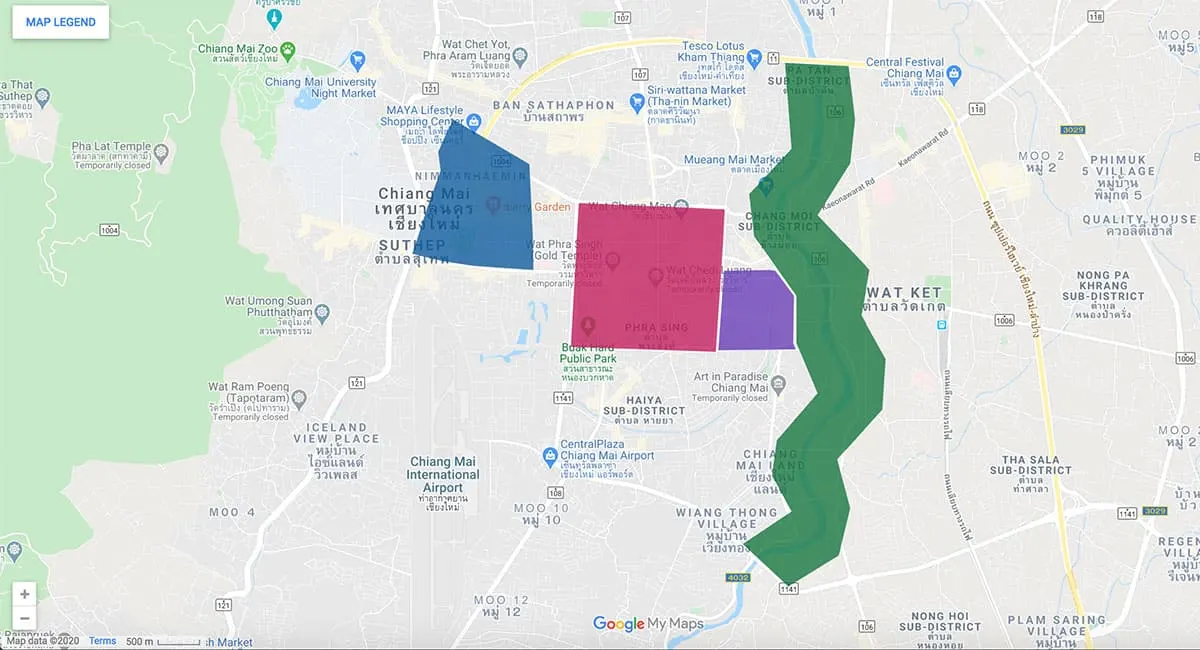
OLD CITY
The Old City is the historical part of town and the heart of Chiang Mai. Measuring about 1.5 sq km and surrounded on all sides by a moat, it’s a former walled city that’s home to many temples, hotels, and restaurants.
Sherloft is primarily a hostel but they do have several private rooms as well. I know many young travelers like staying at “Instagrammable” places these days and Sherloft is exactly that. Check out my post on Sherloft Home & Hostel for more pictures and information.
You can book a room at Sherloft through Booking.com or Agoda. If you’d like to stay in the area but don’t feel this is the right place for you, then you can check these links for alternate listings: Booking.com | Agoda. Check out some of the top-rated hotels in the Old City:
- Luxury: The Inside House
- Midrange: 18 In Town Homestay
- Budget: The Newnormal House
NIMMANHAEMIN
Nimmanhaemin, or Nimman for short, is a trendy area northwest of the Old City. It’s a lively area with plenty of modern bars and restaurants. If you’d prefer to stay in a more contemporary part of town, then this is definitely where you’ll want to be.
1 Nimman Gallery is a boutique hotel just off Nimmanhaemin Road, close to the Maya Lifestyle Shopping Centre. It’s a Lanna-style hotel characterized by dark wood furnishings and ethnic accents.
You can book a room at 1 Nimman Gallery Hotel through Agoda. If you’d like to stay in the area but don’t feel that this is the right place for you, then you can check these links for alternate listings: Booking.com | Agoda. Check out some of the top-rated hotels in Nimman:
- Luxury: Akyra Manor Chiang Mai
- Midrange: BED Nimman – Adults Only
- Budget: Daizy House
NIGHT BAZAAR
On the east side of the Old City and before the Ping River is a “night bazaar” area with a few night markets, including the city’s biggest – Chiang Mai Night Bazaar.
Asian night markets are a lot of fun. The atmosphere is lively and they offer plenty of options for shopping, food, and entertainment. The nightlife is great though the area can get a bit congested.
You can search for accommodations in the Night Bazaar area on Booking.com or Agoda. Here are some of the top-rated hotels in the area:
- Luxury: Anantara Chiang Mai Resort
- Midrange: Yaang Come Village Hotel
- Budget: Tamada House
RIVERSIDE
You’ll find plenty of hotels by the banks of the Ping River, most of which are on the luxury spectrum. They offer good views and a more relaxed environment.
If you stay close enough to the Night Bazaar area, then you can easily walk to the night markets. The Old City will be about a 10-minute Grab ride away.
You can search for accommodations in the Riverside area on Booking.com or Agoda. Check out some of the top-rated hotels in the area:
- Luxury: RatiLanna Riverside Spa Resort
- Midrange: Hongkhao Village
- Budget: Zzhouse
You can also book hotels and homestays in Chiang Mai using the handy map below.
TEMPLES TO VISIT IN CHIANG MAI
There are over 300 Buddhist temples in Chiang Mai. Listed below are six of the most interesting.
1. Wat Phra Singh
There are a few Buddhist temples in Chiang Mai Old City, but Wat Phra Singh is the biggest and most beautiful. Known as “The Temple of the Lion Buddha”, it dates back to the 14th century when Chiang Mai was the capital of the Lanna Kingdom.
Like any of the temples in the Old City, you can explore Wat Phra Singh on your own, but if you’d like to learn more about its history, then you can book a guided tour through Klook or Get Your Guide.
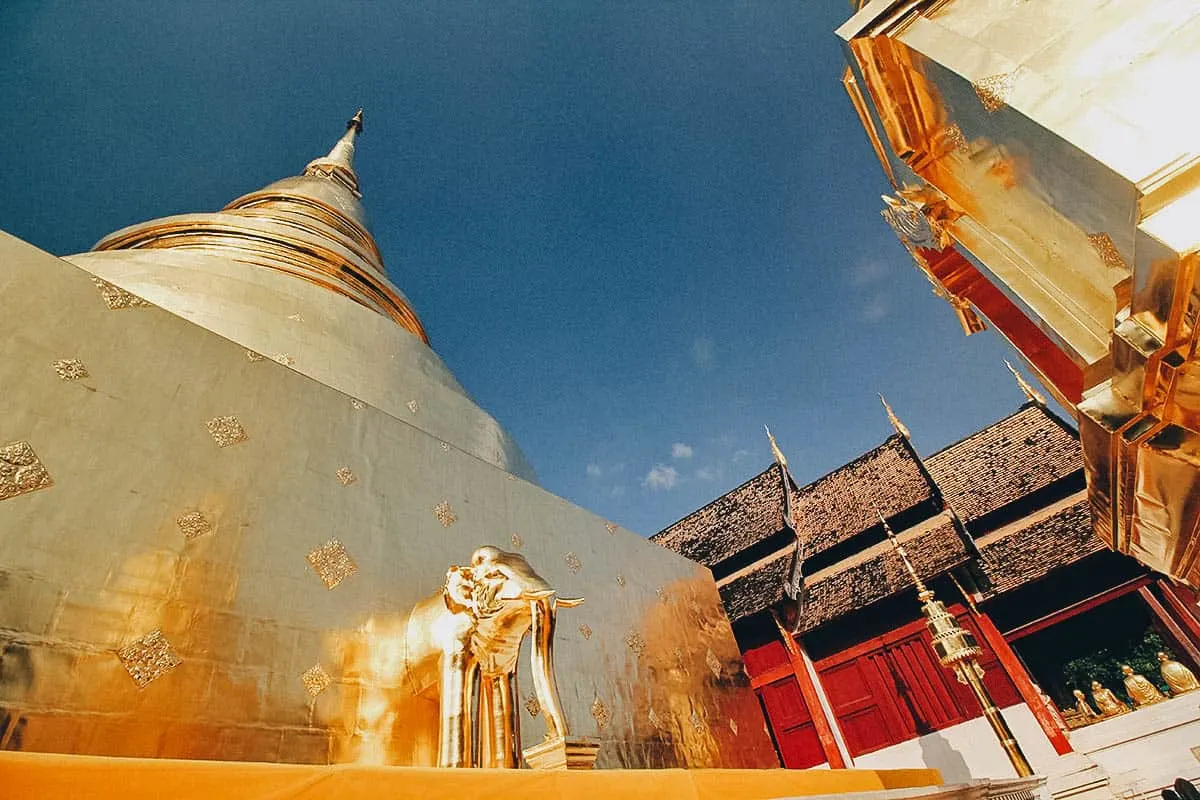
Operating Hours: 6AM-8PM, daily
Admission: FREE (THB 50 for the main viharn)
Estimated Time to Spend: About 1 hr
2. Wat Chedi Luang
Enter the temple grounds and the first thing you’ll notice is this massive stupa. Wat Chedi Luang is known as “The Temple of the Great Stupa” because of its impressive chedi.
Much of the chedi has been destroyed by an earthquake but at its peak, it measured about 85 meters (279 ft) tall and 44 meters (144 ft) wide, making it the biggest structure in Chiang Mai. At one point, Thailand’s revered Emerald Buddha was kept at Wat Chedi Luang.
Many of the guided tours (Klook | Get Your Guide) that take you to Wat Phra Singh will also take you to Wat Chedi Luang.
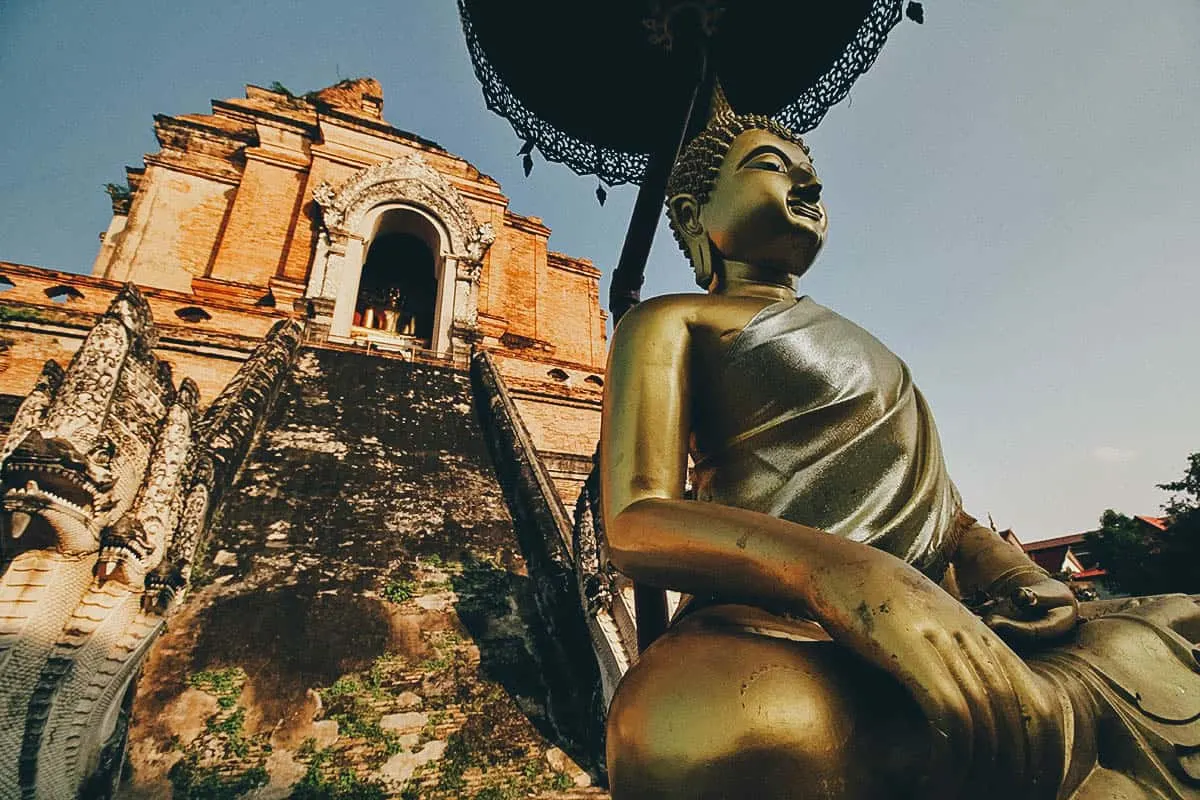
Operating Hours: 6AM-6PM, daily
Admission: FREE
Estimated Time to Spend: About 30 mins – 1 hr
3. Wat Phra That Doi Suthep
I’ve been to many temples in Thailand and I find Wat Phra That Doi Suthep to be one of the most beautiful. It’s a stunning sight, glistening in gold against a clear blue sky.
Wat Phra That Doi Suthep is located on a mountain about 15 km west of the Old City. It takes less than an hour to get there by songthaew which you can catch at the North Gate. You can refer to my article on Doi Suthep for more information.
Alternatively, you can visit Wat Phra That Doi Suthep on a guided tour that you can book through Klook or Get Your Guide. Bhubing Palace (Royal Winter Palace) and a number of hilltribe villages are in the same area so a few of those tours will be making stops there as well.
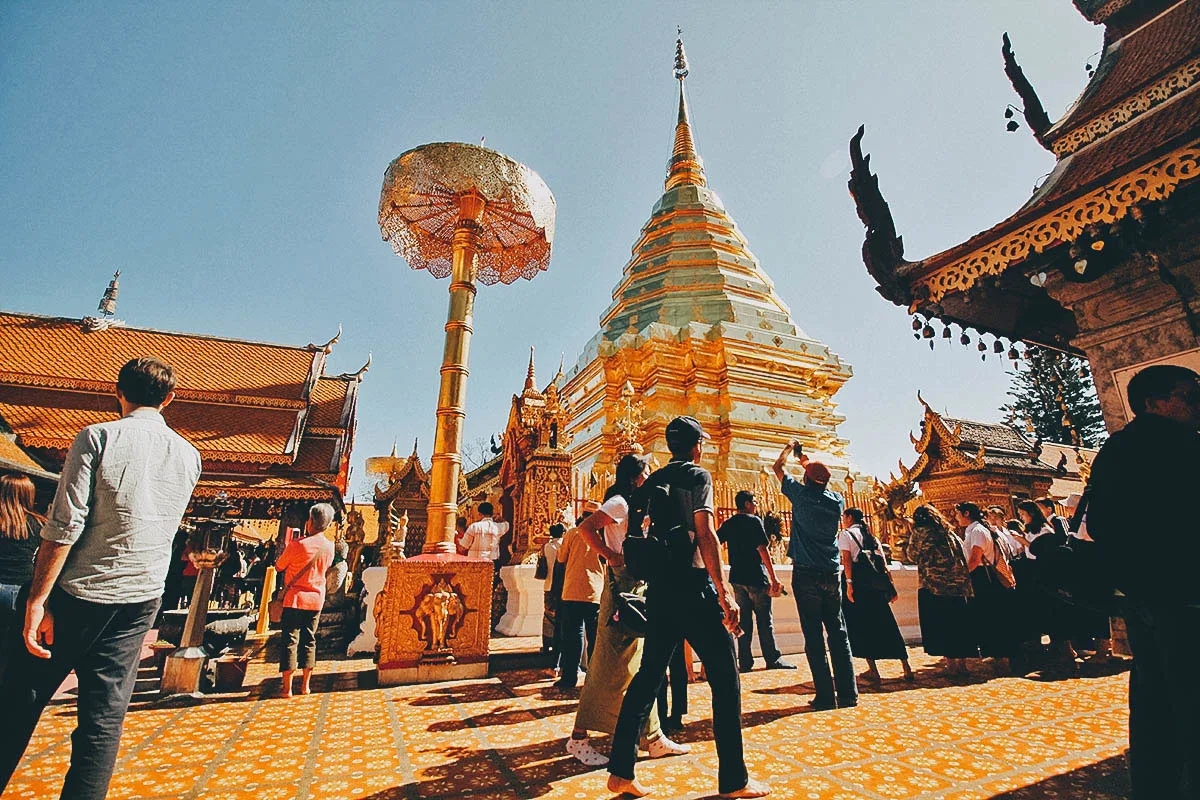
Operating Hours: 6AM-8PM, daily
Admission: THB 100
Estimated Time to Spend: About 2-3 hrs
4. Wat Umong Suan Phutthatham
Wat Umong was the most unique temple I visited in Chiang Mai. It’s unique because of its series of tunnels carved out of an artificial mound with a large bell-shaped chedi (pictured below) on top. You can go inside the tunnels to see a series of shrines with Buddha images.
Wat Umong Suan Phutthatham is located in a heavily wooded area in the foothills of Doi Suthep Mountain. It’s a peaceful and relaxing site that doesn’t get as crowded as the more famous temples in Chiang Mai.
However, it isn’t as easy to get to. It’s about 4.5 km west of the Old City so it’s easiest to visit by Grab, rental car, or scooter. You can also go on a guided tour.
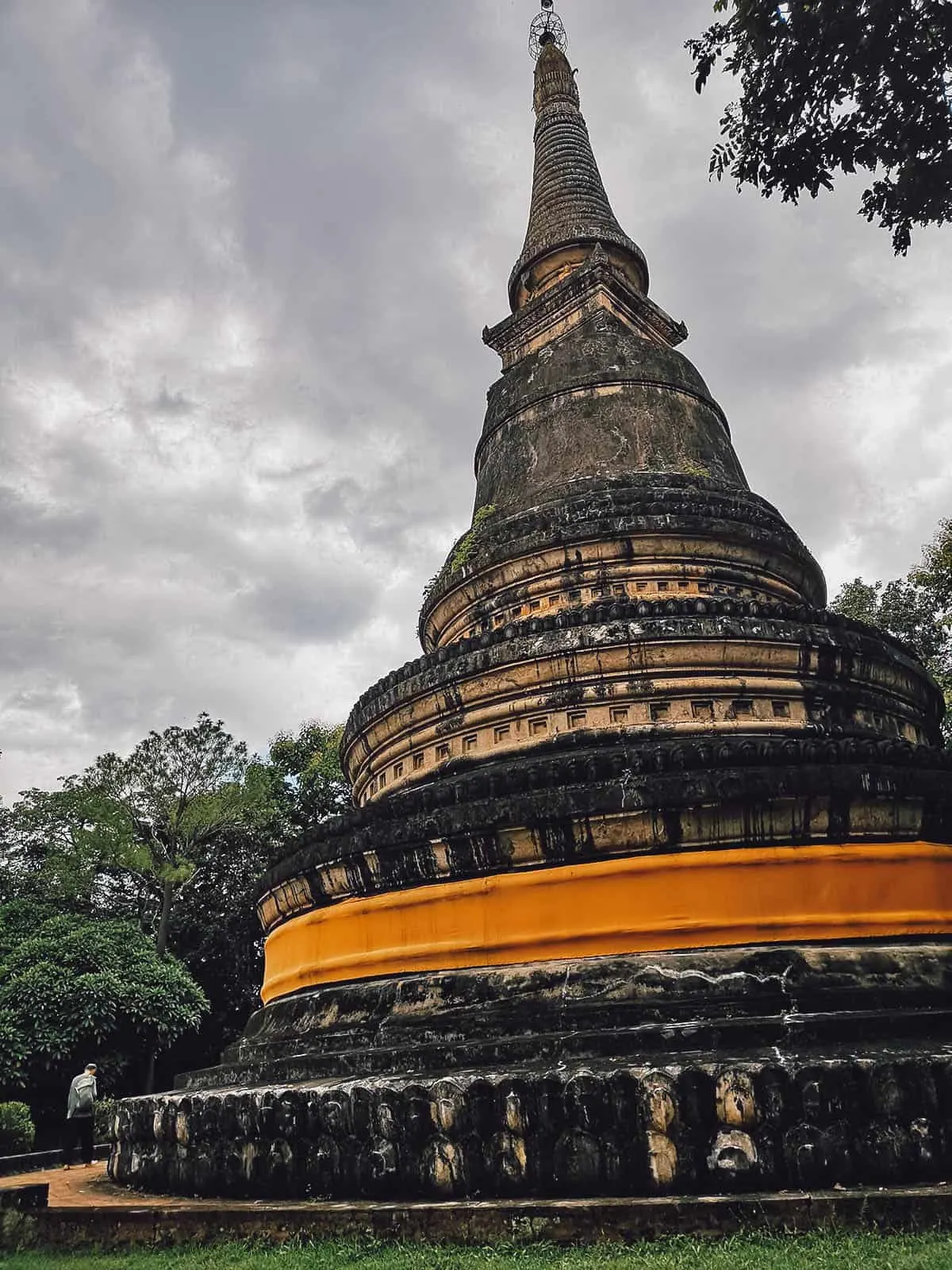
Operating Hours: 8AM-5PM, daily
Admission: FREE
Estimated Time to Spend: About 1 hr
5. Wiang Kum Kam
Wiang Kum Kam is an ancient city that served briefly as the capital of the Lanna Kingdom, before the capital was moved to Chiang Mai. The town became buried in mud and silt in the 16th century before being excavated in the late 20th century.
A total of 42 monuments in various states of restoration have been excavated at the site. Pictured below is Wat Chedi Liam, the only ancient temple at Wiang Kum Kam that remains a working temple with resident monks.
Wiang Kum Kam is located about 7 km south of the Old City so it’s easiest to go by Grab, rental car, or scooter. You can also explore the site on a guided tour.
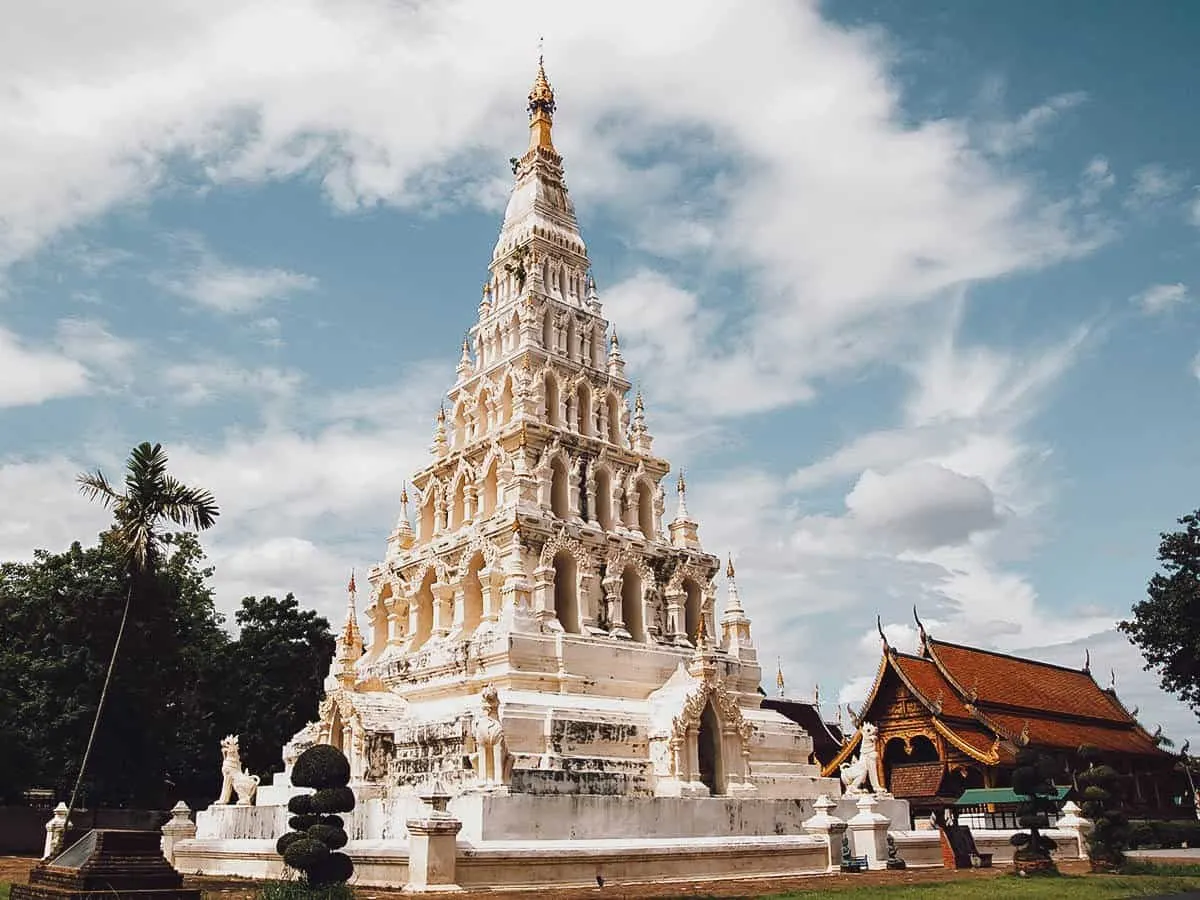
Photo by janniwet via Shutterstock
Operating Hours: 7AM-5PM, daily
Admission: FREE
Estimated Time to Spend: About 1-2 hrs
6. Wat Pa Dara Phirom
Wat Pa Dara Phirom is a century-old royal temple in Mae Rim, about 15 km north of the Old City. It’s described as one of the most significant temples in Chiang Mai, though it isn’t as well-known to foreign tourists. Much of that has to do with its location.
Wat Pa Dara Phirom is about a 40-minute drive from the Old City so it’s best to visit in a rental car or scooter. We made a stop here on or way back to Chiang Mai from Pai. It’s a striking temple and well worth the effort.
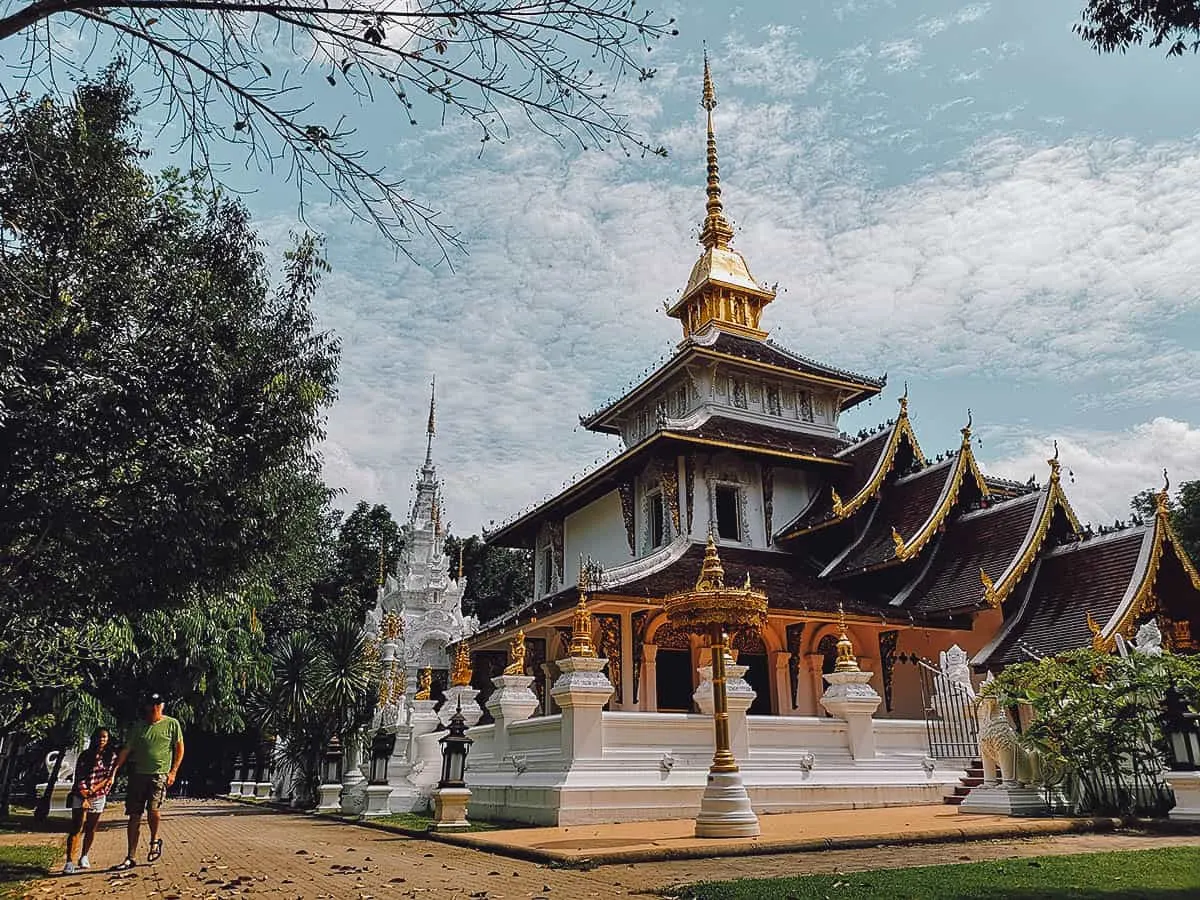
Operating Hours: 9AM-5PM, daily
Admission: FREE
Estimated Time to Spend: About 1-2 hrs
THINGS TO DO IN CHIANG MAI
1. Celebrate the Yee Peng & Loy Krathong Festivals
The Yee Peng Festival is celebrated around November of every year and draws in thousands of visitors to Chiang Mai. It’s characterized by the simultaneous release of these large paper lanterns into the night sky.
The Loy Krathong Festival happens around the same time as Yee Peng and involves the release of floating leaf containers with candles down a river.
The Yee Peng Festival is a highly sought after event with tickets going on sale as early as January. If you want to purchase tickets or need help planning for it, then you can refer to our Yee Peng Festival guide.
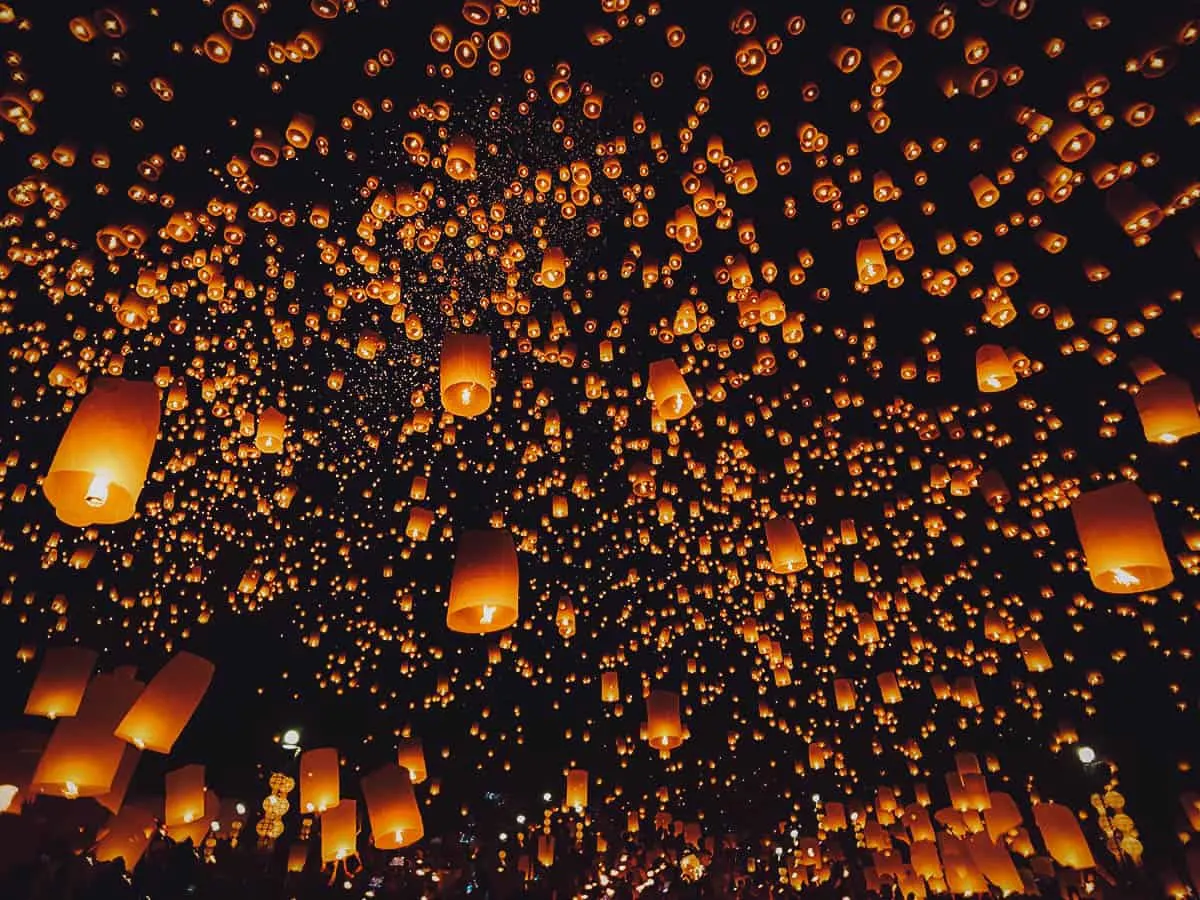
Photo by matthew25 via Shutterstock
2. Enjoy a Khantoke Dinner and Show
A khantoke is a traditional Thai Lanna meal that’s offered to guests to celebrate special occasions. Strictly speaking, it refers to the round pedestal tray used as a dining table during the meal.
The Old Chiang Mai Cultural Center has been offering khantoke dinners with traditional Thai Lanna dancing shows since 1971. Check out my post on this khantoke dinner for more pictures and information.
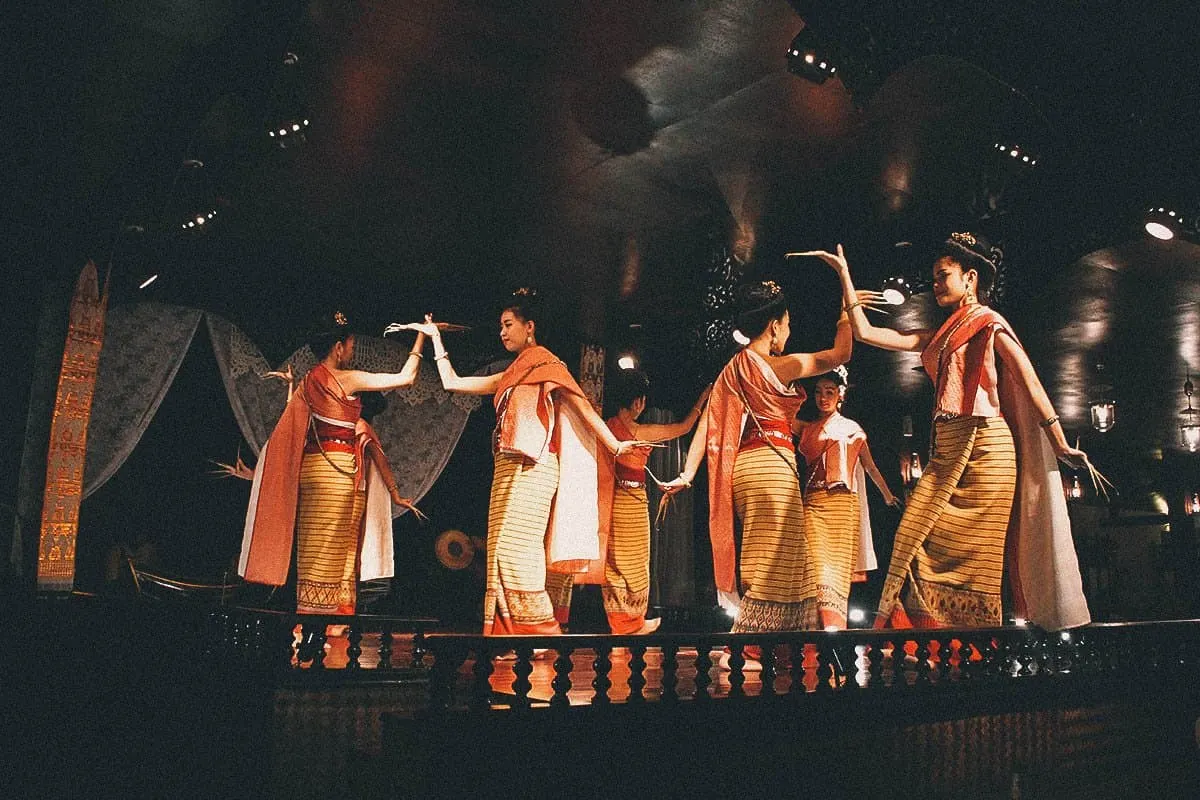
3. Go on a Food Tour
We love going on food tours. It’s one of the best ways to learn about obscure hole-in-the-walls, the types of eateries that locals love but don’t always show up on Google.
Those are exactly the types of places you’ll find on this food tour with A Chef’s Tour. You’ll be taken to some of Chiang Mai’s best local markets and eateries to try northern Thai favorites like sai oua (sausage), larb (pork salad), and nam ngiaw (Shan noodle soup). Check out my article on the Chiang Mai Northern Food Tour by Truck for more pictures and information.
You can also check out Get Your Guide for food tours in Chiang Mai: Option 1 | Option 2
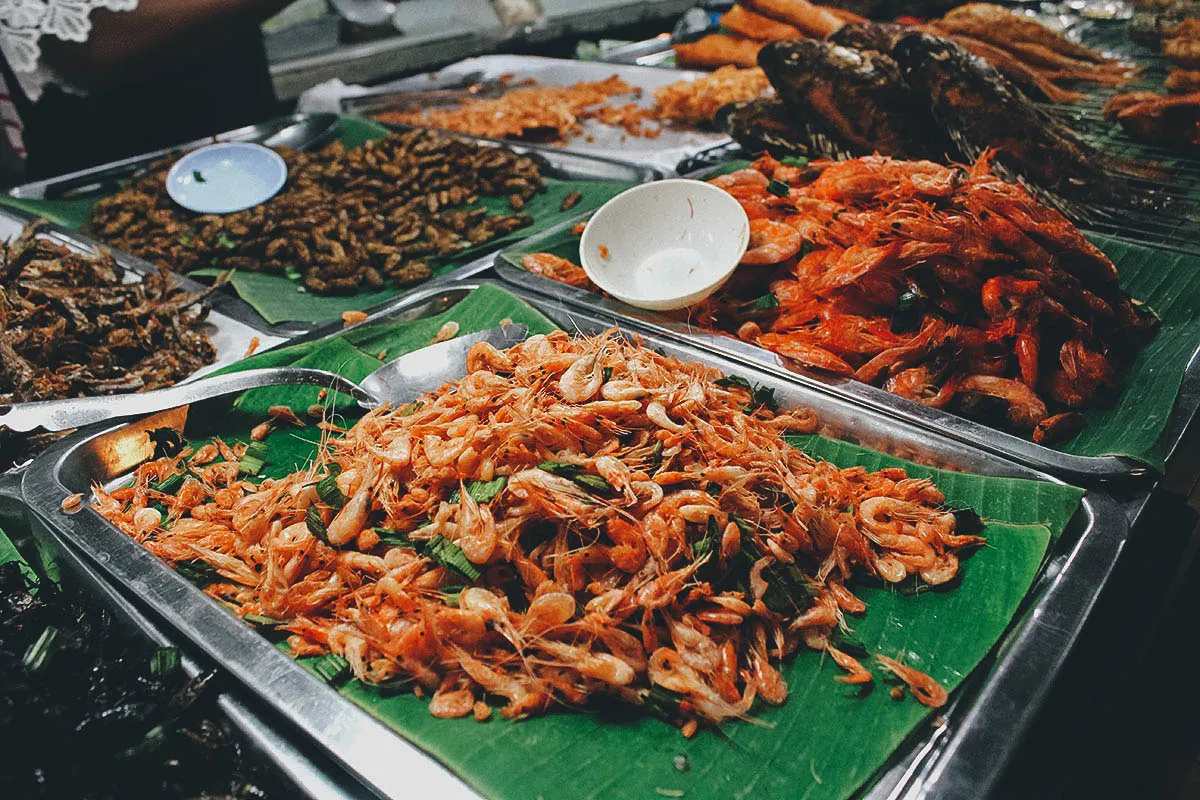
4. Go Ziplining in the Jungle
Ziplining and other adrenaline-inducing activities are popular in Chiang Mai. There are many of these adventure parks to choose from, offering a wide range of activities like ziplining, white water rafting, bungee jumping, and more. Check out Klook for a list of adventure-filled activities in Chiang Mai.
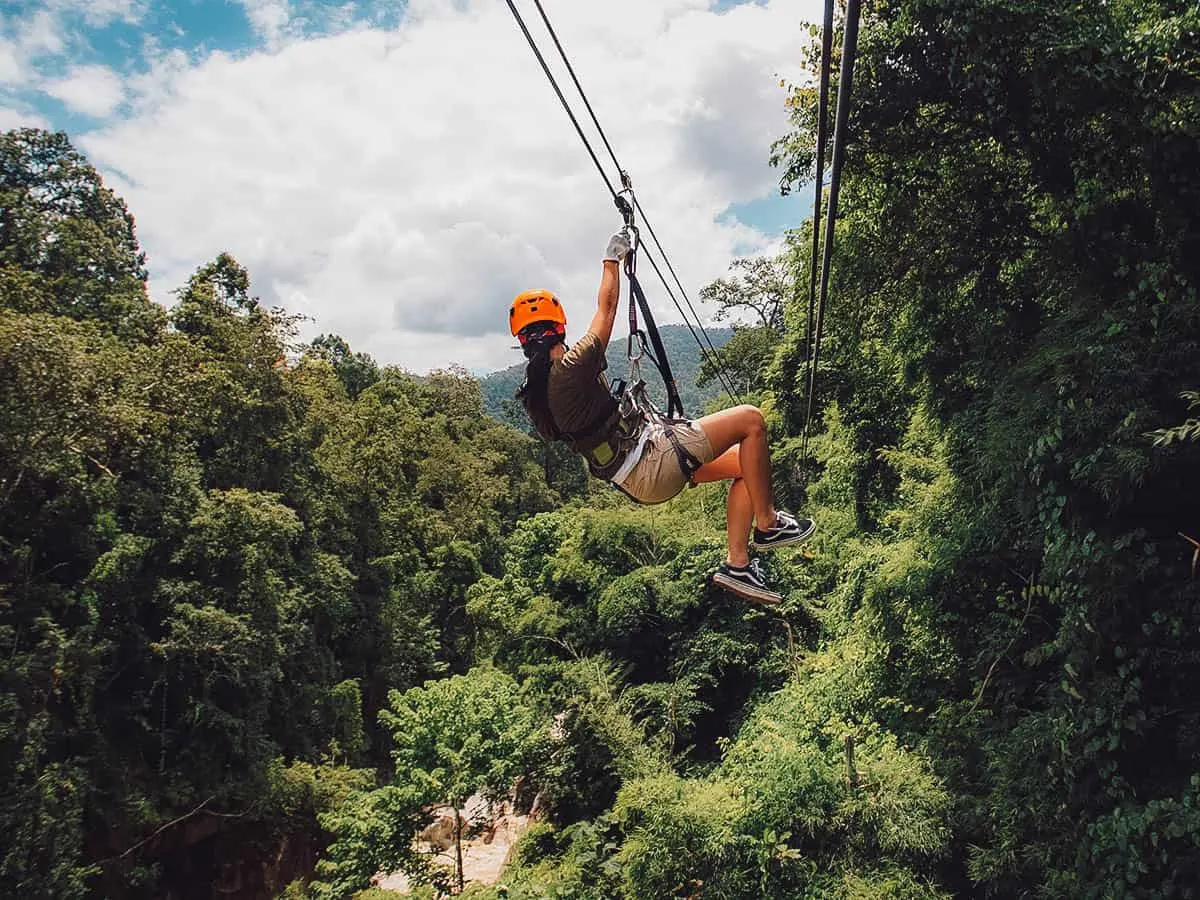
Photo by aounphoto via Shutterstock
5. Pamper Yourself at a Spa
Getting a massage is one of the best things you can do in Thailand. If you’d like a day of relaxation and pampering in Chiang Mai, then why not treat yourself to a massage or spa treatment?
Ren got a massage at Kiyora Spa and said it was the best massage she’s ever gotten in her life. Klook and Get Your Guide have several massage and spa treatment packages to choose from in Chiang Mai.
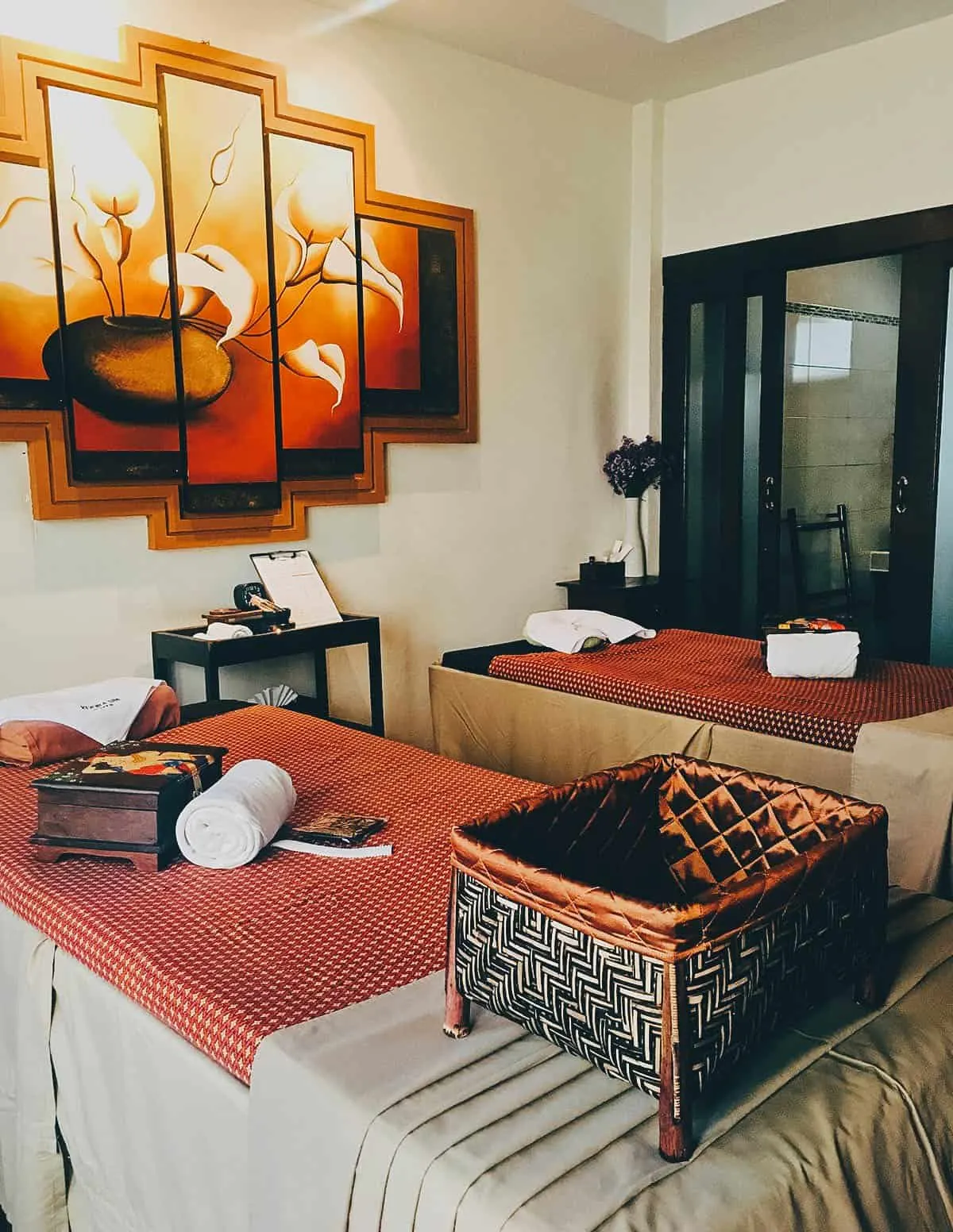
6. Take a Thai Cooking Class
Cooking classes are among the most popular things to do in Chiang Mai, which isn’t surprising considering how delicious and widely accepted Thai food is.
We took a fun cooking class at Mama Noi Thai Cookery School where we learned how to make classic Thai dishes like pad thai, green curry, and Thai iced tea. You can book the same class on Klook.
You can also search for Chiang Mai cooking classes on Cookly. It’s a booking platform dedicated to cooking classes so you’ll have plenty to choose from.
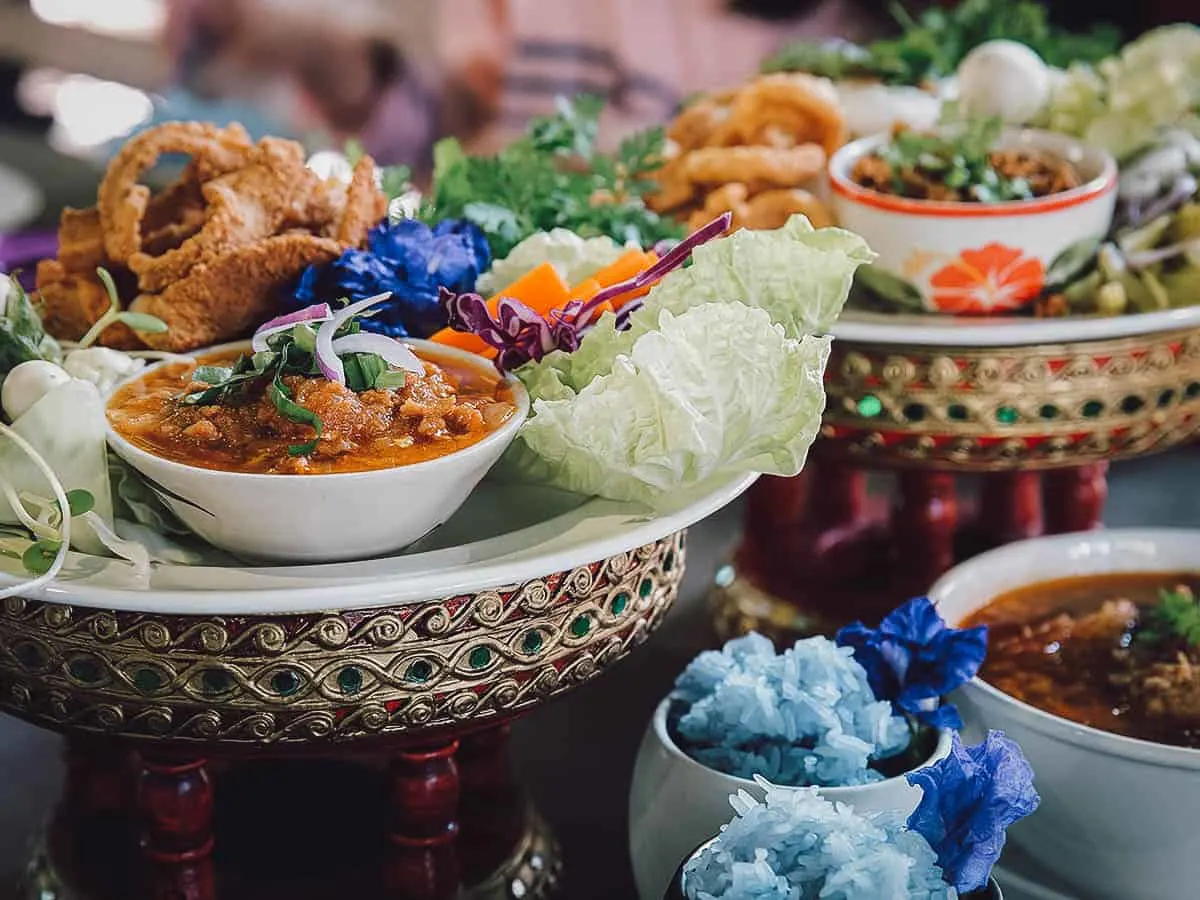
Photo by anek.soowannaphoom via Shutterstock
7. Explore a Night Market
Night markets are a big part of Thai culture. Chai Mai’s biggest night market is located in the Night Bazaar area but there are plenty to choose from throughout the city. You can refer to this excellent article on some of the best night markets in Chiang Mai for suggestions.
Pictured below is Ploen Ruedee Night Market, a fun western-style night market near Chiang Mai Night Bazaar. It’s a more upscale night market offering a wide range of international cuisines.
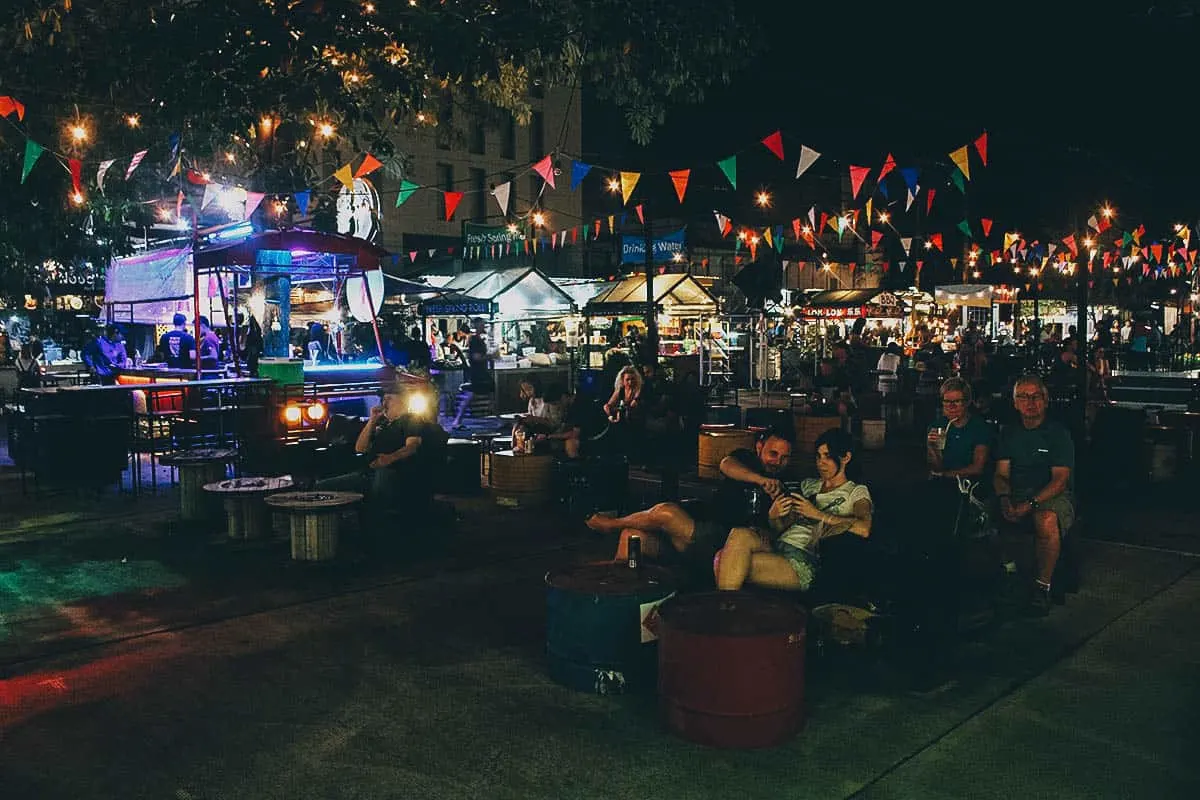
8. Go on a Bike Tour
Renting bikes or going on a bike tour is an excellent way of exploring Chiang Mai. Many of the temples recommended in this guide are a few kilometers from the Old City so renting bicycles may be a good way of exploring them.
If you’d like to go on a bike tour, then you can book one through Klook or Get Your Guide.
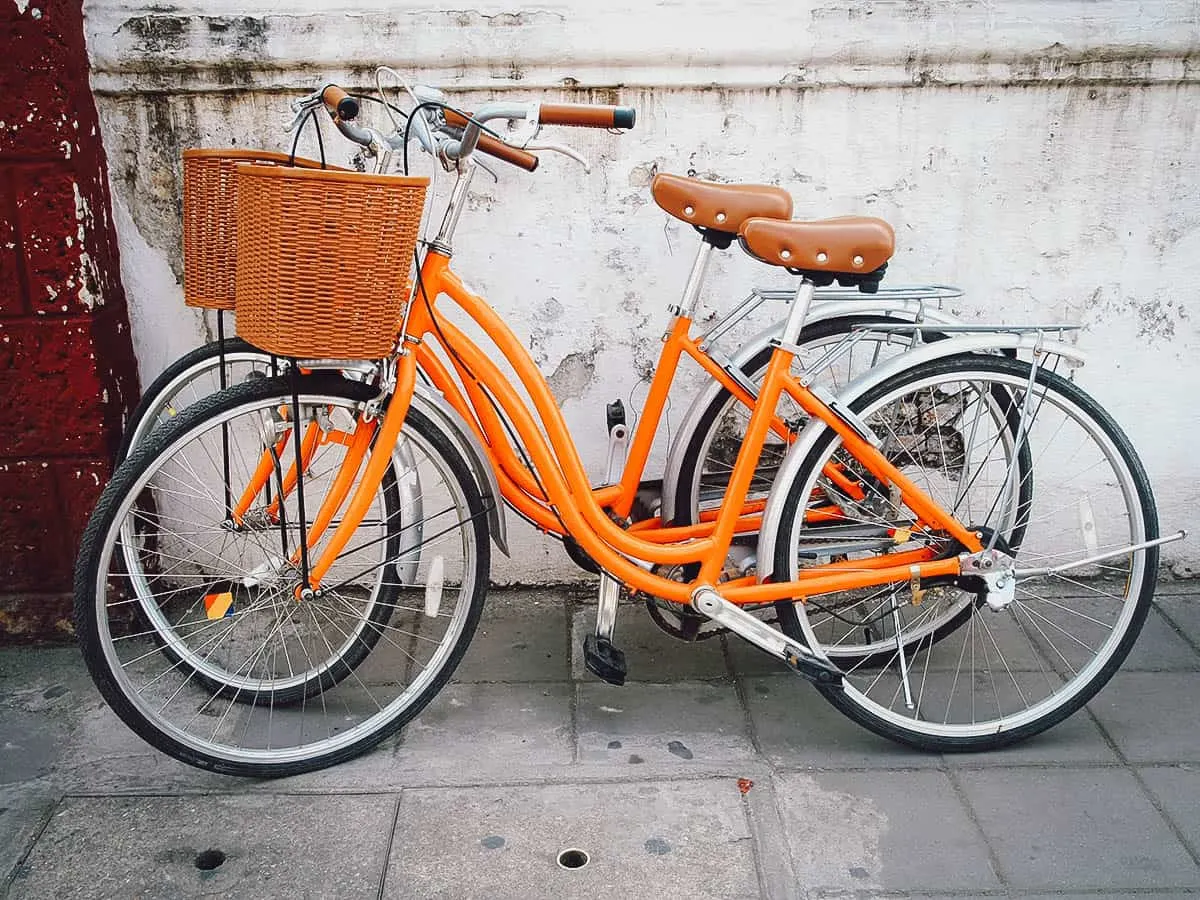
Photo by aodaodaodaod via Shutterstock
9. Watch Muay Thai LIVE!
If you’re a fan of combat sports, then you may want to catch a muay thai event live.
In Chiang Mai, you can watch kickboxing matches at Chiang Mai Boxing Staidum or Thapae Boxing Stadium. They’re regional stadiums so they aren’t nearly as big as Bangkok’s Lumpinee or Rajadamnern, but I read that matches are competitive enough and fun to watch.
The stadiums can get crowded so it’s recommended to purchase tickets in advance. Click on the link to get tickets to Thapae Boxing Stadium through Klook.
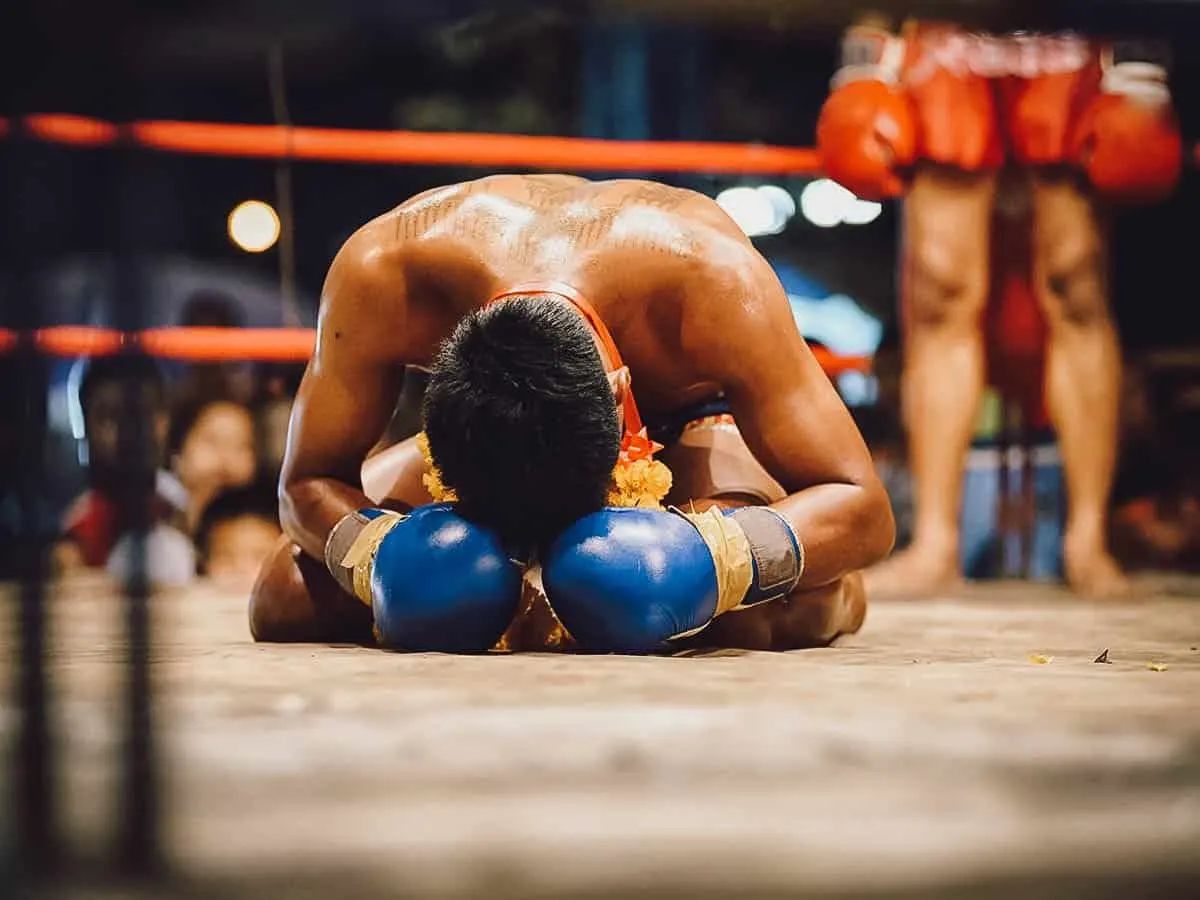
Photo by SIRIWAT SUMANGKA via Shutterstock
DAY TRIPS FROM CHIANG MAI
1. Elephant Nature Park
Elephant Nature Park is Thailand’s premier animal sanctuary and rescue center. Located about an hour and a half away from the Old City, they have over 30 elephants at the park, most of whom were rescued from the tourism or illegal logging industries.
The park employs a Visit & Volunteer program where tourists can stay for the day or up to an entire week working with the elephants. You can read my article on Elephant Nature Park for more pictures and information. It’s a wonderful and incredibly rewarding experience.
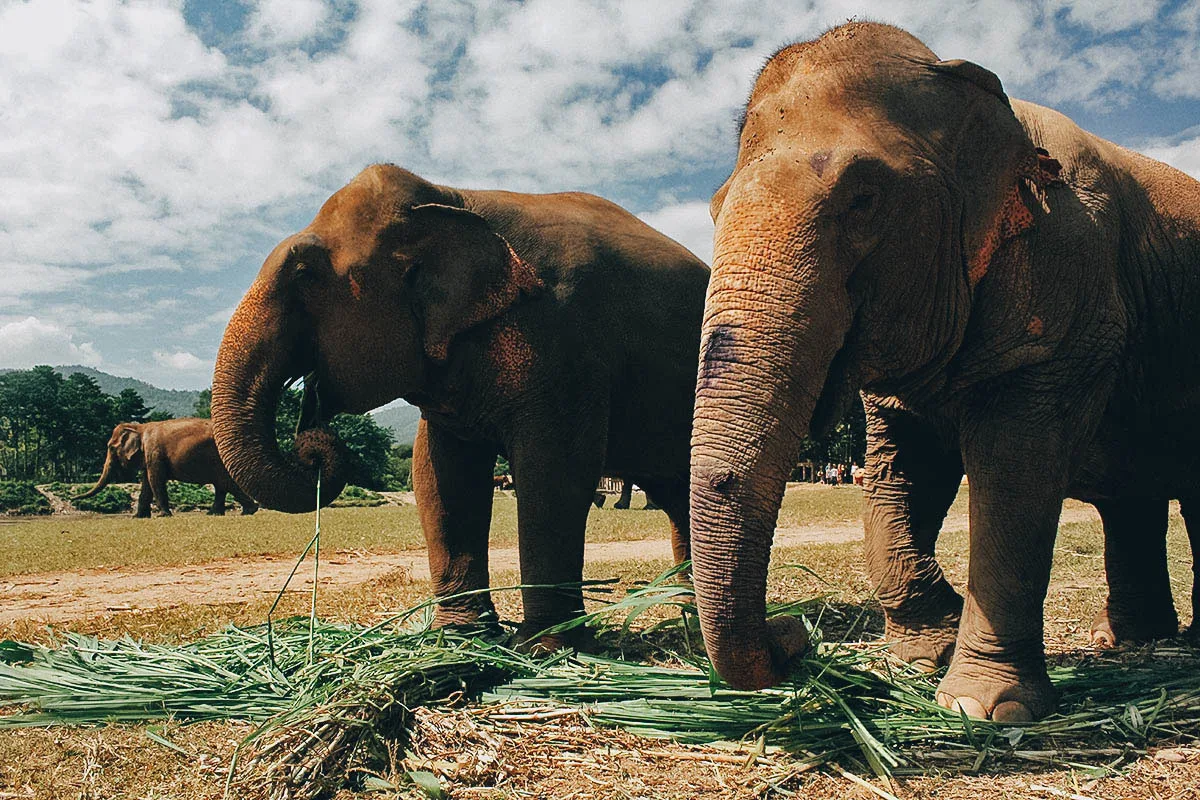
2. Doi Inthanon National Park
Doi Inthanon is Thailand’s highest mountain. At its peak, it has an elevation of 2,565 meters (8,415 ft) and offers the most breathtaking views of Chiang Mai.
The park is known for its many waterfalls and hiking trails, though its perhaps best known for its towering twin chedis built in honor of King Bhumibol Adulyadej and Queen Sirikit.
Doi Inthanon National Park is over two hours away from the Old City so it’s easiest to visit on a guided tour which you can book through Klook or Get Your Guide. You can read my article on Doi Inthanon National Park for more pictures and information.
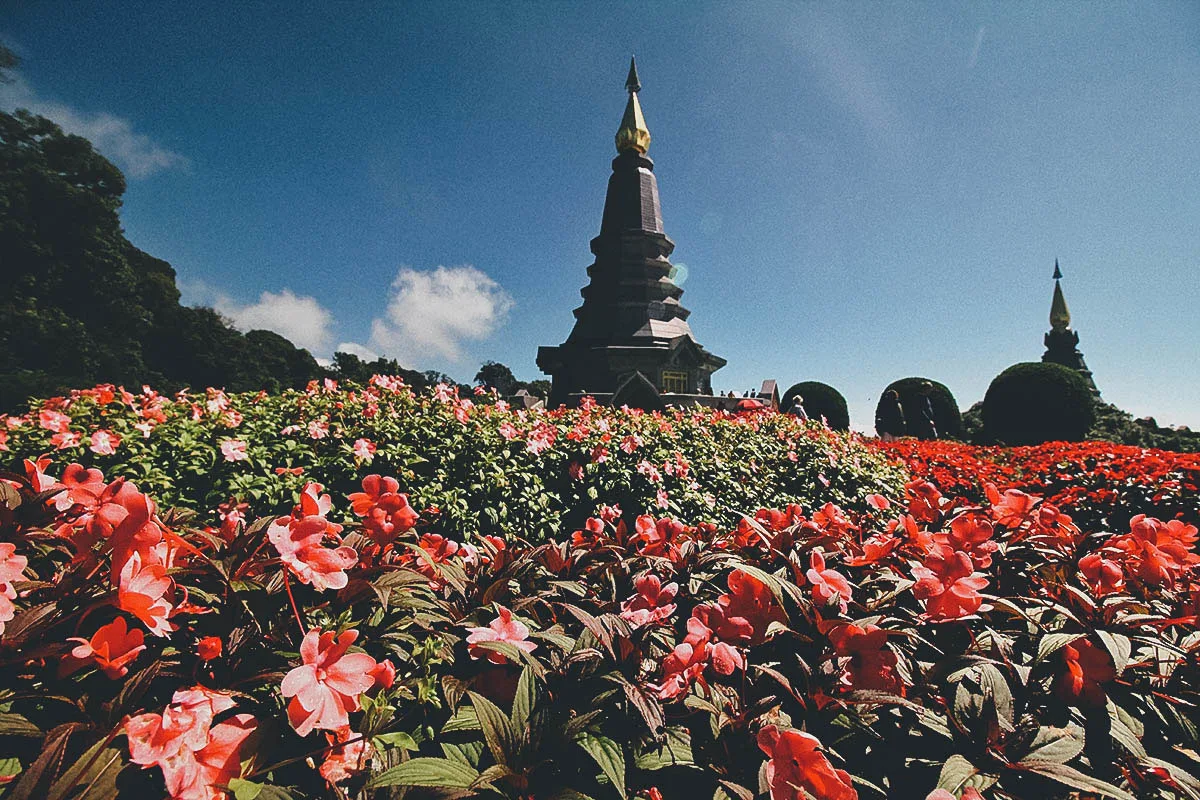
3. Chiang Dao Caves
If you’re in the mood to go spelunking in Chiang Mai, then you may want to visit Chiang Dao Caves. It’s a 12-km network of sacred caves with shrines and stalactite and stalagmite formations.
Chiang Dao is located about 75 km north of the Old City so it’s best to go in a rental car or scooter. There are scenic trekking routes in the area that you can explore with a guide so you may want to make a whole day of it. If you aren’t comfortable renting a car or scooter, then you can go on a guided tour.
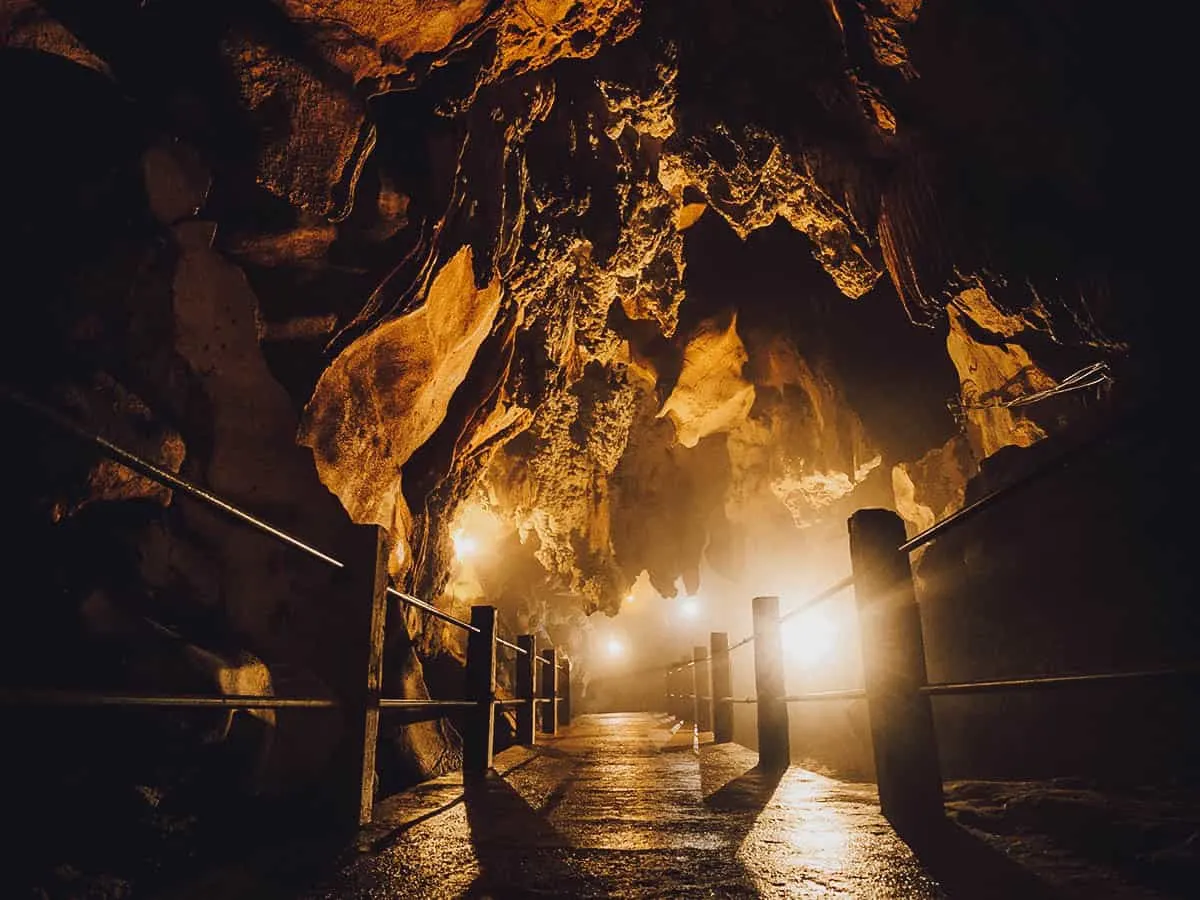
Photo by Kaiplapan via Shutterstock
4. Chiang Rai
Similarly named and just three hours away by bus, Chiang Rai is synonymous with Chiang Mai. Many tourists who travel to the region often visit both.
Chiang Rai isn’t as big as Chiang Mai but it’s home to one of Thailand’s most interesting and unique temples, Wat Rong Khun or the White Temple.
Klook and Get Your Guide offer several day tours to Chiang Rai from Chiang Mai. If you’d like to stay longer, then you can go there on your own by bus. Check out our first-timer’s travel guide to Chiang Rai to help you plan your trip.
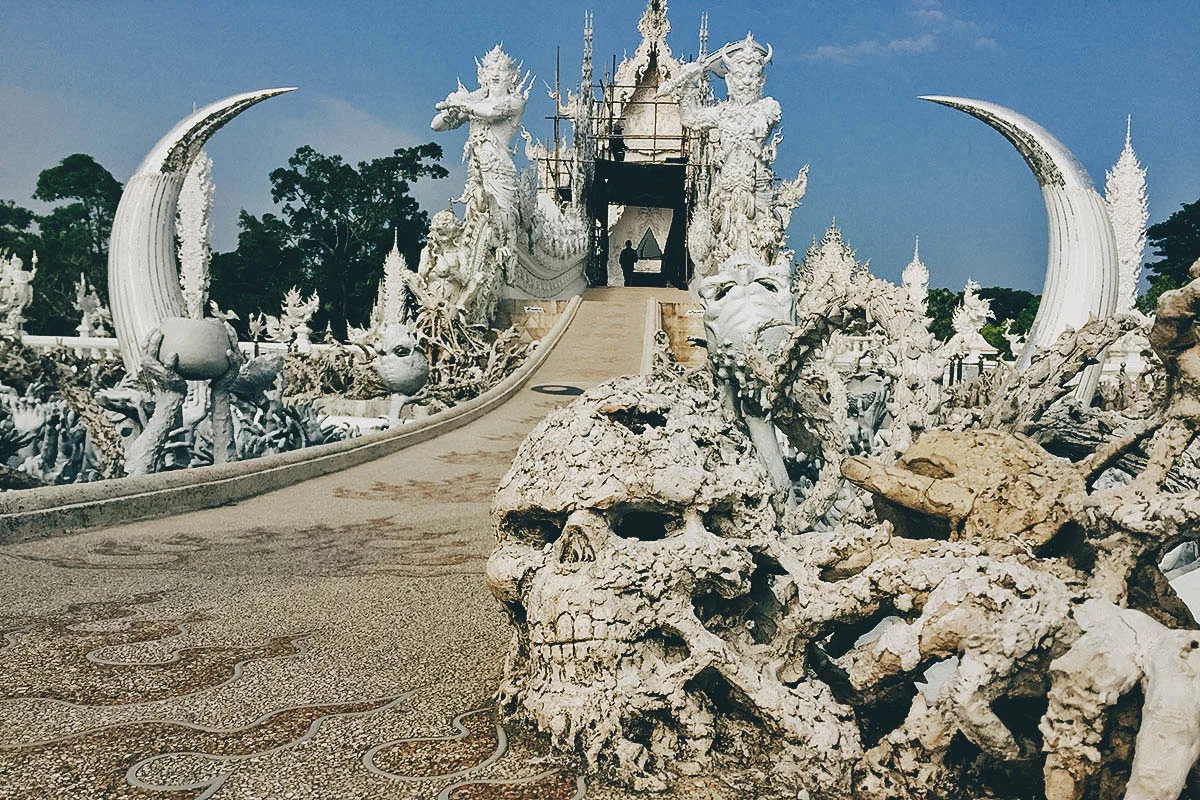
THAI FOOD GUIDE
Thailand is one of the best countries to visit for food. Most people know abut pad thai but if you’d like to really dig into the cuisine, then be sure to check out our Thai food guide for a list of 45 must-try dishes in Thailand.
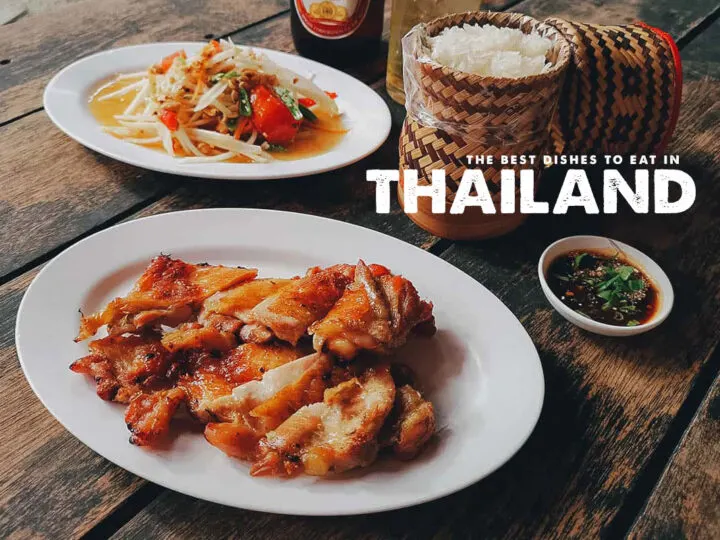
THAI DESSERTS
Savory Thai dishes are amazing, but so are Thai desserts. If you have a sweet tooth, then you’ll definitely want to look for these 25 traditional Thai desserts on your next visit to Chiang Mai.
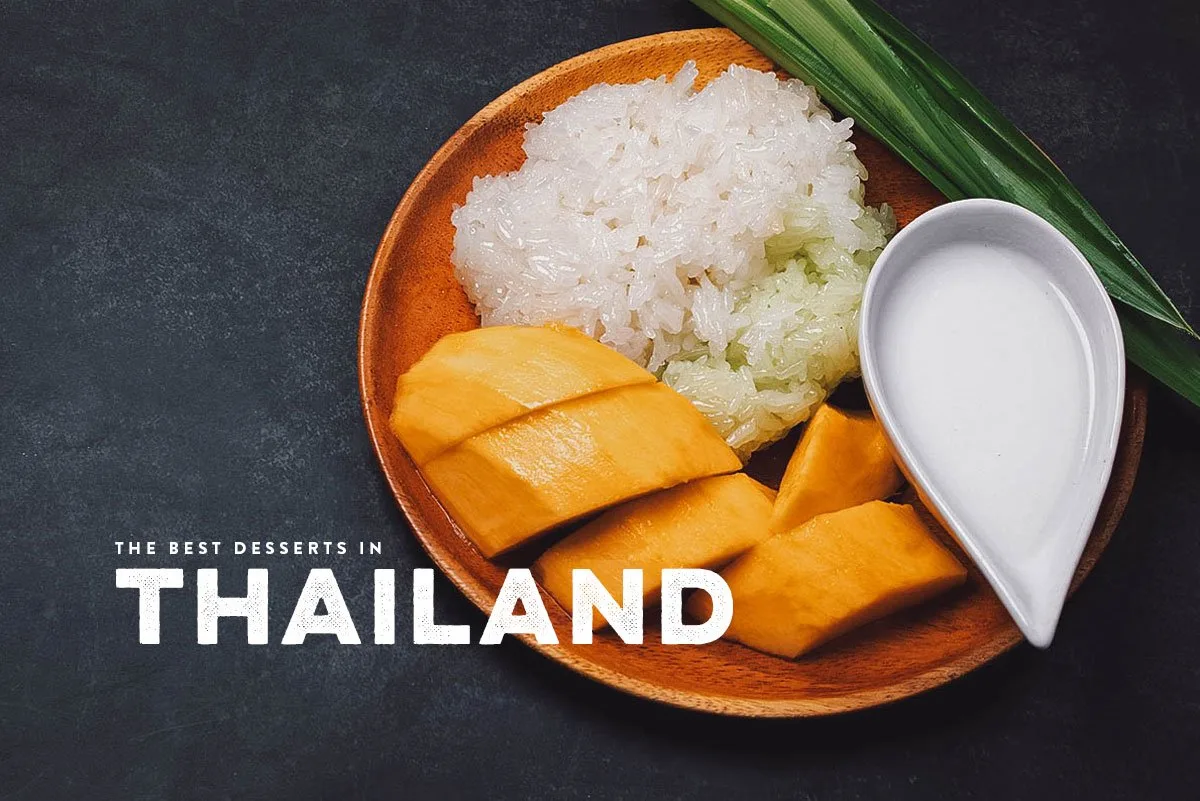
WHERE TO EAT IN CHIANG MAI
If you’re looking for great local eateries, then you can check out our article on must-try restaurants and street food stalls in Chiang Mai. Listed below are four of our favorites, but be sure to click through to the full article for more pictures and information. It includes many plant-based restaurants as well.
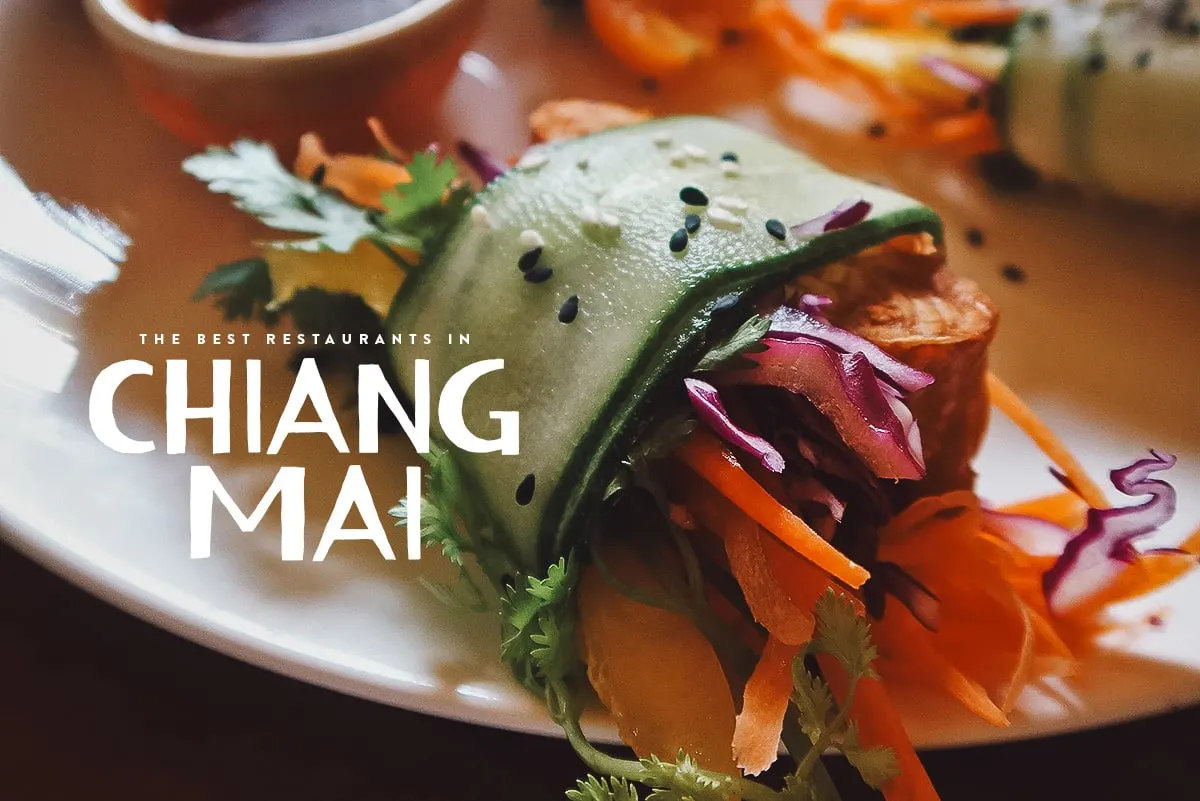
1. Khao Soi Khun Yai
Every trip to Northern Thailand should begin with a bowl of khao soi. It’s the quintessential northern Thai dish of crispy and soft egg noodles in a creamy, curry-like sauce made with coconut milk.
We had khao soi several times in Chiang Mai and Chiang Rai, and the version here at Khao Soi Khun Yai was our favorite. It was delicious – rich and creamy without being too sweet.
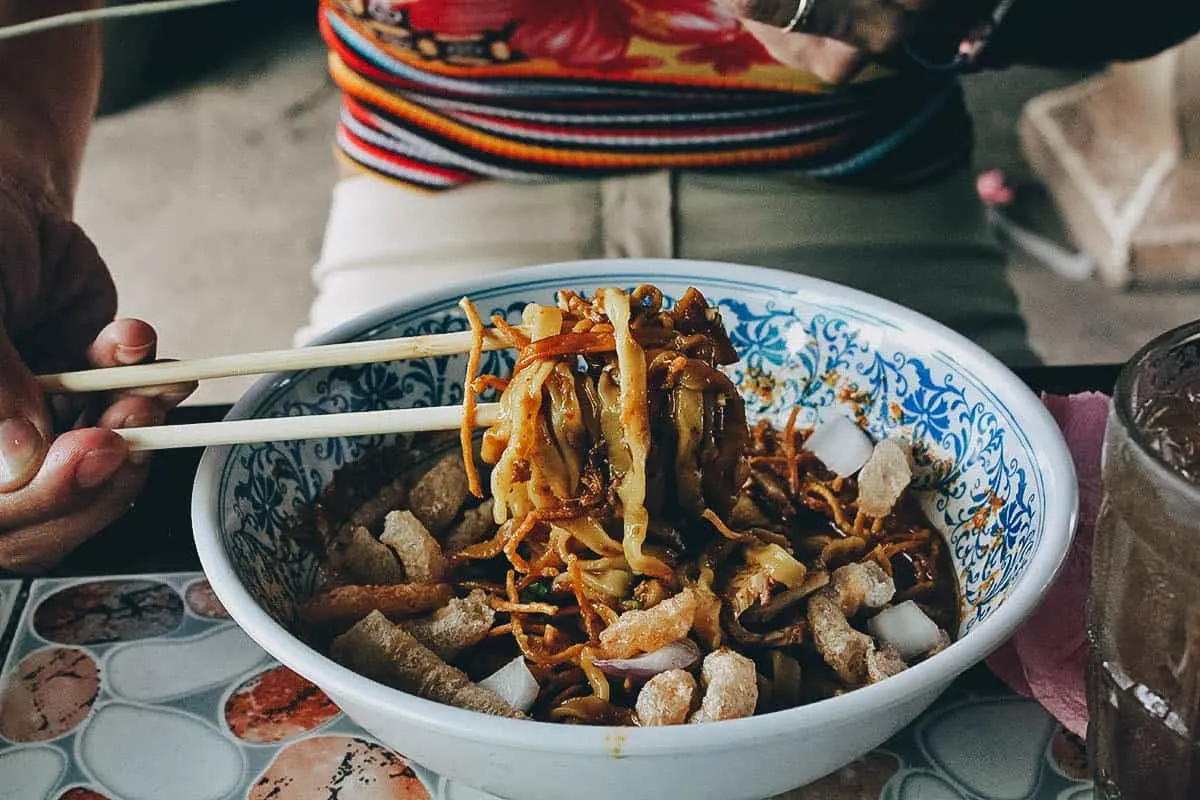
2. Khao Kha Moo Chang Phueak (Cowboy Hat Lady)
If khao soi is Chiang Mai’s most famous dish, then this food stall is perhaps its most popular. And part of that has to do with this lady badass wearing a 10 gallon cowboy hat.
Known as the Cowboy Hat Lady, she’s been described as a Chiang Mai institution with a reputation for serving some of the best khao kha moo in town.
Khao kha moo is braised pork leg cooked in Chinese five spice and served over rice with a medium-boiled egg. Cowboy Hat Lady’s khao kha moo is fall-off-the-bone tender and absolutely delicious.
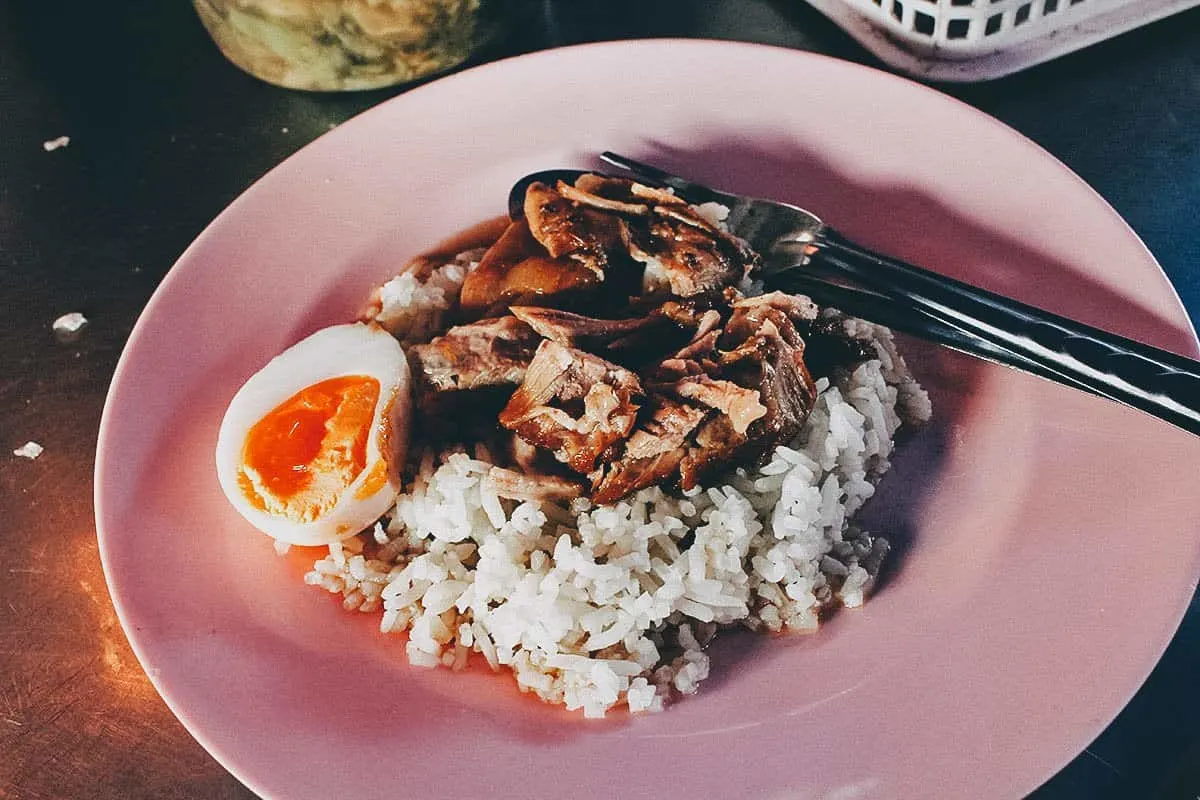
3. Suki Koka
Located in the same cluster of food stalls as the Cowboy Hat Lady, this bowl of Thai suki was one of our favorite things to eat in Chiang Mai.
Served wet or dry, Suki Koka’s Thai suki consists of vegetables cooked with mung bean noodles and a mix of seafood or your choice of meat. They make it with heaps of cabbage cooked briefly in a wok at high heat, keeping it crunchy whilst giving it that wonderful smokey wok hei flavor.
Like Khao Kha Moo Chang Phueak, it’s one of the most popular eateries in this cluster of North Gate food stalls. Don’t leave Chiang Mai without eating at both.
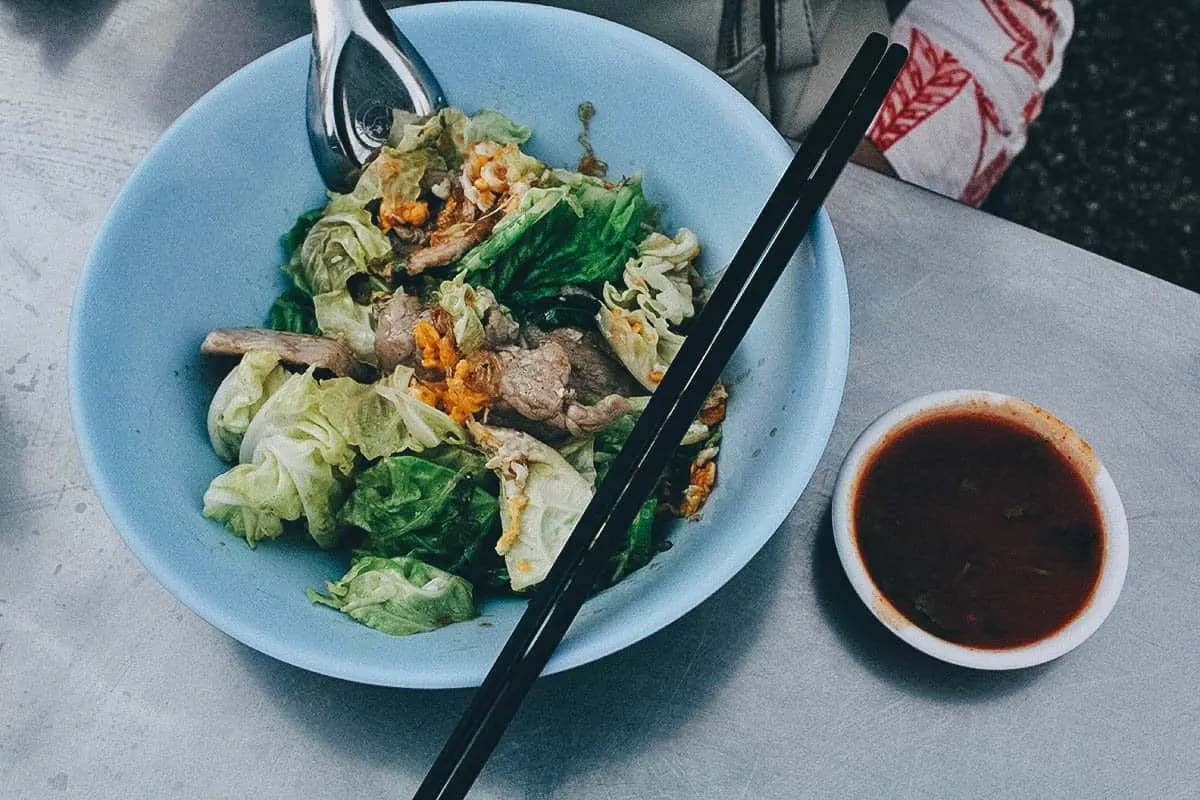
4. Cherng Doi Roast Chicken
If you’re in the mood for kai yang or roast chicken, then Cherng Doi should be at the top of your list.
Kai yang is an Isaan dish that’s now popular throughout Thailand. A whole chicken is often halved and pounded flat before being marinated then slowly grilled over a low charcoal flame.
Cherng Doi Roast Chicken is often cited for serving some of the best kai yang in Chiang Mai. The meat was tender and juicy with nicely crisped skin. Delicious!
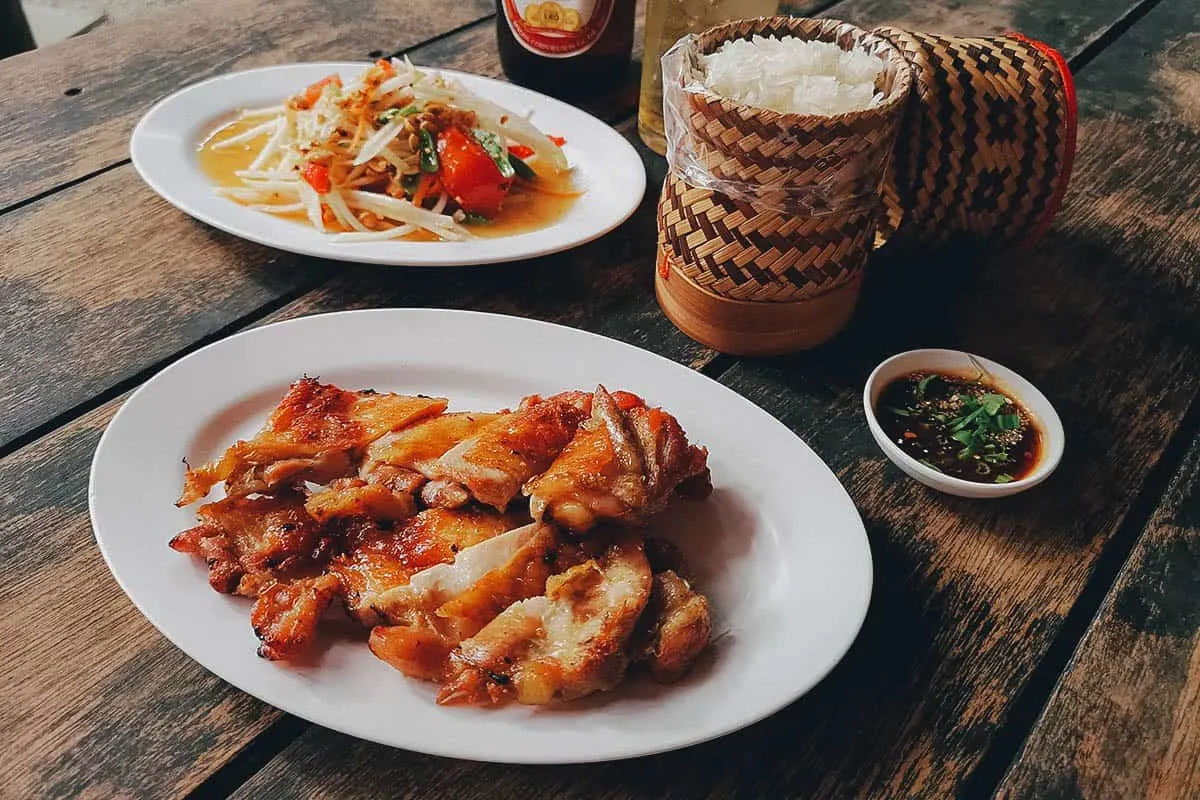
POINTS OF INTEREST IN CHIANG MAI
To help you navigate, I’ve created this map so you get a better sense of where everything is. Click on the link for a live version of the map. All the places recommended in this guide are pinned on this map.
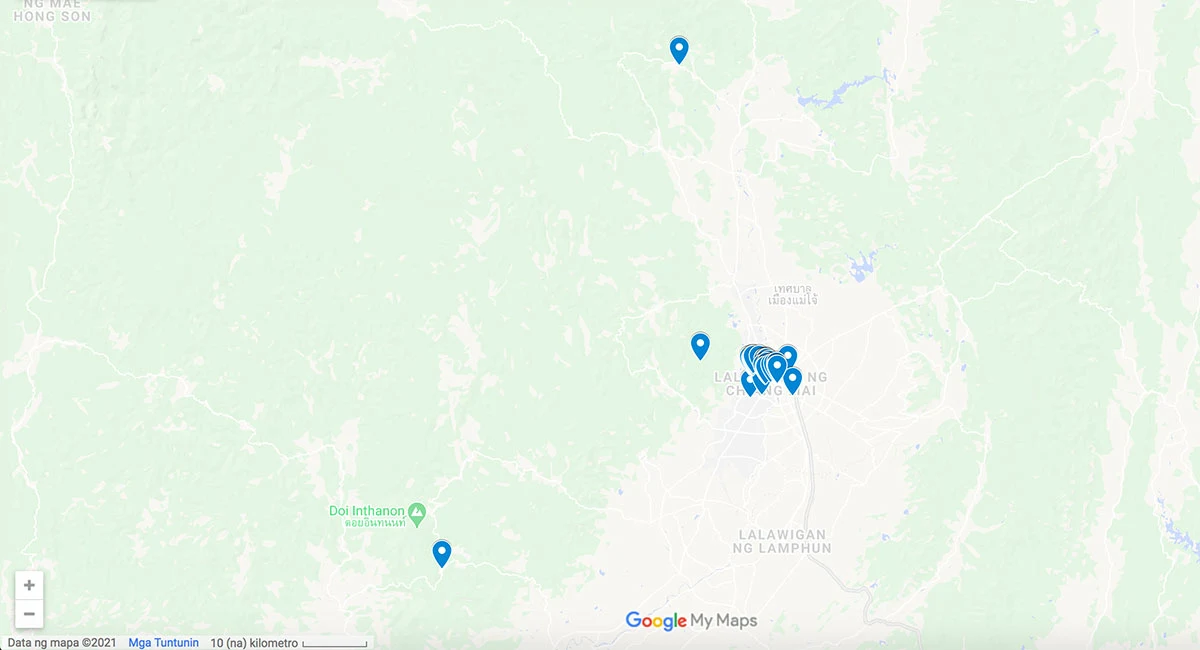
HOW TO GET AROUND IN CHIANG MAI
If you’re staying in the Old City, then it’s easy enough to get around on foot. But there are times when you may have to go farther.
Songthaew
The cheapest and most common way of getting around Chiang Mai is via those red trucks with two rows of seats called songthaews. If you’ve been to the Philippines, then you’ll find them similar to public jeepneys.
I only rode it once to go to Doi Suthep and from what I understand, they cost a minimum of THB 30 per ride.
You can hail any passing songthaew and tell the driver where you want to go. If he’s going in that direction, then he’ll quote you the fare amount and tell you to hop in the back. If not, then you can wait for the next one to come along.
I don’t have too much experience with them but you can refer to this excellent post on public songthaews for more information.
Grab
While songthaews may be the cheapest form of transportation, it isn’t the most convenient. Whenever we needed to go somewhere outside of the Old City, we would use Grab instead.
Grab is more expensive than songthaews but still relatively cheap, especially since our hostel would provide us with promo codes.
We took seven Grab rides in all and they averaged out to just over THB 51 per ride, with the most expensive trip being from our hostel to the airport for THB 85.
If you aren’t traveling too far and don’t want to deal with the hassle of public songthaews, then Grab is an excellent alternative.
HOW MANY DAYS TO STAY / CHIANG MAI ITINERARY
Chiang Mai isn’t the bustling metropolis that Bangkok is but there’s plenty to do here. On top of that, it’s one of those destinations that invite slow travel.
Assuming you aren’t in town to celebrate festivals like Yee Peng or Songkran, then I’d say 3 full days is enough time to give you a good feel for the city. But stay longer if you can.
Here’s a sample 3D/4N Chiang Mai itinerary to help you plan your trip.
| DAY ONE • Wat Phra That Doi Suthep • Bhubing Palace • Wat Umong Suan Phutthatham • Wat Phra Singh • Wat Chedi Luang • North Gate Food Stalls |
| DAY TWO • Elephant Nature Park • Khantoke dinner and show at Old Chiang Mai Cultural Center |
| DAY THREE • Chiang Dao • Wat Pa Dara Phirom • Chiang Mai Night Bazaar • Ploen Ruedee Night Market |
CHIANG MAI TRAVEL TIPS
1. Plan your Trip with Sygic Travel
There are two types of travel planners – those who enjoy it and those who don’t. If you enjoy it like I do, then Sygic Travel will be useful to you. It’s a free trip planning app that helps you make efficient itineraries. I’ve been using it for several years now and you can download it for free on iOS and Android.
2. Rent a Pocket Wifi Device
It goes without saying that having a strong and steady internet connection is a must these days. We need it to perform daily tasks like checking email and connecting on social media. On a trip, it becomes even more important because we need it to navigate and do last minute research.
Assuming you’ll be spending time in Bangkok first, you can rent a 4G pocket wifi device through Klook which you can pick up and drop off at either airport (Suvarnabhumi or Don Mueang). If you prefer, you can get a 4G sim card instead.
3. Plan Early for the Yee Peng Festival
If you’re going to Chiang Mai to celebrate the Yee Peng Festival, then you’ll need to plan your trip early. It’s a popular event which sees thousands of tourists flocking to the city and trying to snap up a limited number of tickets.
Tickets sell out quickly so I suggest reserving yours and planning your trip as early as possible. Tickets have been known to go on sale as early as January.
4. Pick the Right Elephant Sanctuary
Chiang Mai is known for its many elephant centers. However, not all are legitimate. Many pose as “sanctuaries” to attract tourists but still engage in cruel practices.
If you read about any facilities that allow elephant riding or force the animals into performing tricks like doing headstands or painting pictures, then that’s NOT the sanctuary you want to go to.
People are entertained out of ignorance but these tourism-related activities are rooted in cruel practices like elephant crushing and the use of bull hooks to control the animals.
If you’re an animal lover and don’t want to support elephant cruelty, then go to a true sanctuary and rescue center like Elephant Nature Park. It’s one of the best and most reputable in Thailand.
5. Check for Chiang Mai Travel Deals
There are many websites that offer deals to tours and other travel-related services. In Chiang Mai, I suggest going through Klook and Get Your Guide. They both offer a wide range of deals on things like tours, shows, pocket wifi rental, airport transfers, and more.
6. Get Travel Insurance
To be honest, we don’t always get travel insurance. It depends on where we’re going, how long we’ll be away for, and what we’ll be doing.
If we’re just going on a quick trip to shop and eat, then we probably won’t get it. But if we plan on doing anything physical, then we definitely will.
We bought insurance policies for this trip to Chiang Mai just in case we got accidentally sat on (or shat on) by a misbehaving elephant.
We buy travel insurance from SafetyWing or Heymondo. They’re travel insurance providers often used by digital nomads. You can follow the links to get a free quote from SafetyWing or Heymondo. Get 5% off on Heymondo by using our link.
7. Rent a Car
If you’re comfortable driving in Thailand and want to do some exploring beyond the city center, then the easiest way to do that would be to rent a car. There are many interesting attractions beyond the city’s limits so having a rental car will give you the freedom to explore on your own.
8. Bring the Right Power Adapter
Electrical outlets in Thailand typically feature two-pronged round or flat sockets, either Type A, Type B, Type C, or Type F. Be sure to bring the right power adapters for your devices. Electrical voltage is 220V and the standard frequency is 50Hz.
Have Fun!
By no means am I an expert on Chiang Mai but I do hope this guide helps you plan your trip. I’m only sharing some of the things I learned from our time there. If you have any questions or comments, then please feel free to leave them in the comment section below.
Thanks for stopping by and have a great time exploring Chiang Mai and northern Thailand!
Disclosure
This Chiang Mai travel guide contains affiliate links, meaning we’ll earn a small commission if you make a purchase at no extra cost to you. We only recommend products and services that we use ourselves and firmly believe in. We really appreciate your support as this helps us make more of these free travel guides. Thank you!


Palm Villa Chiang Mai
Wednesday 10th of May 2023
As a fellow traveler, I can relate to your love for Thailand, having visited the country four times while backpacking in my early 20s. It's hard not to be drawn to its captivating charm and beauty. Your compilation of a guide for backpacking in Thailand is truly appreciated and will undoubtedly be beneficial for others who wish to embark on a similar journey. Thank you for sharing your experiences and insights with us! We also highly reccomend Palm Villa Chiang Mai!
AjarnMike
Tuesday 7th of March 2023
Atrocious air pollution at the moment. Do not come to ChiangMai if you value your health.
Rachel Kwong
Monday 20th of February 2023
I downloaded the new local taxi service app called Bolt. It works like Grab but the charge is half the price. To the airport or to Nimman from my hotel - Grab charged 158 baht and Bolt charge 74 baht. Same type of cars
JB & Renée
Monday 20th of February 2023
That's very helpful Rachel! Thanks for sharing. We've personally never used Bolt but we'll check it out for future trips. Cheers.
Jon
Thursday 19th of January 2023
I would add Palm Villa Chiang Mai to the list. It truly is a luxury villa in Chiang Mai and very unique !
Han
Wednesday 3rd of March 2021
June, July August are fantastic months to visit. Basically just September can get so wet that it may be tedious, but most green season months just means a nice early-evening downpour to cool things down. Also nature is much greener, waterfalls are better... I'd pick June over February anytime.